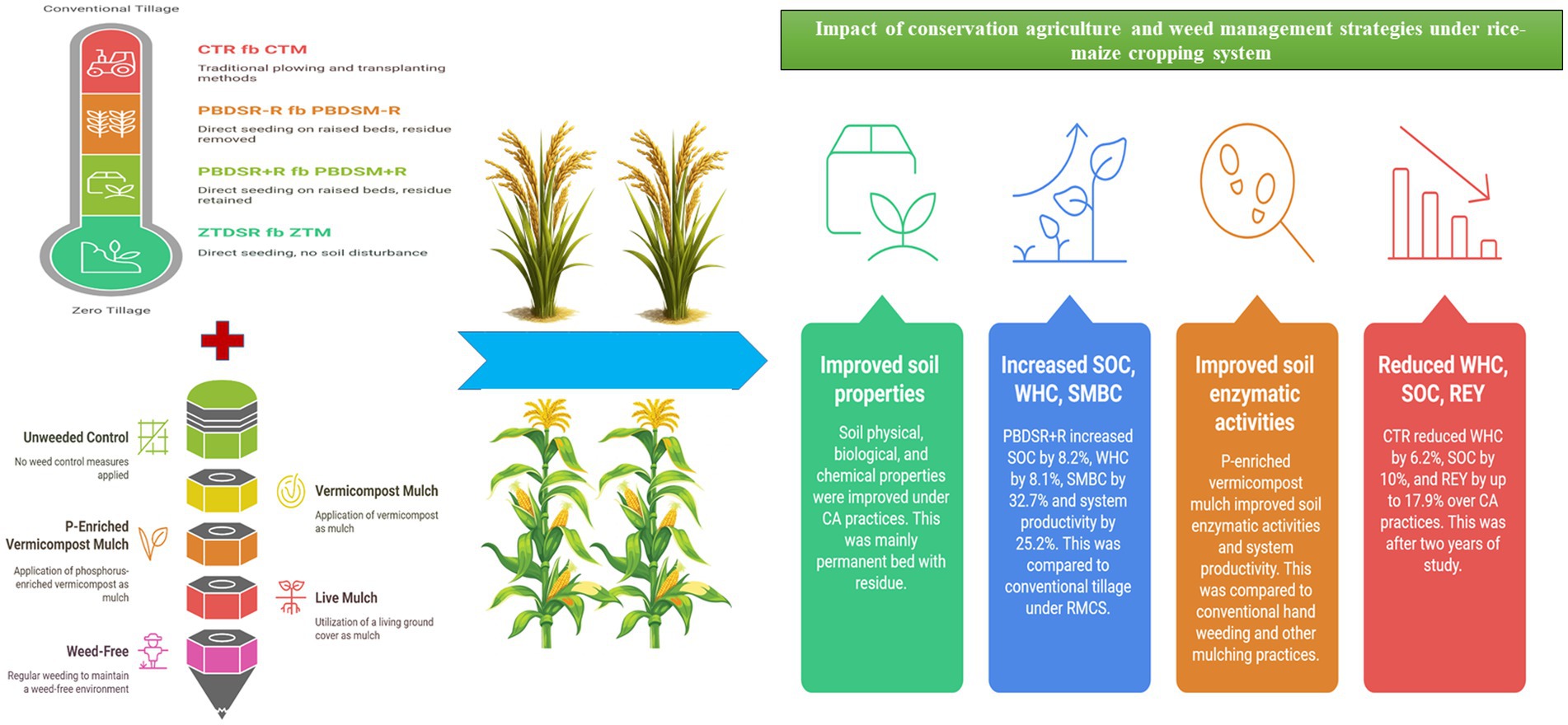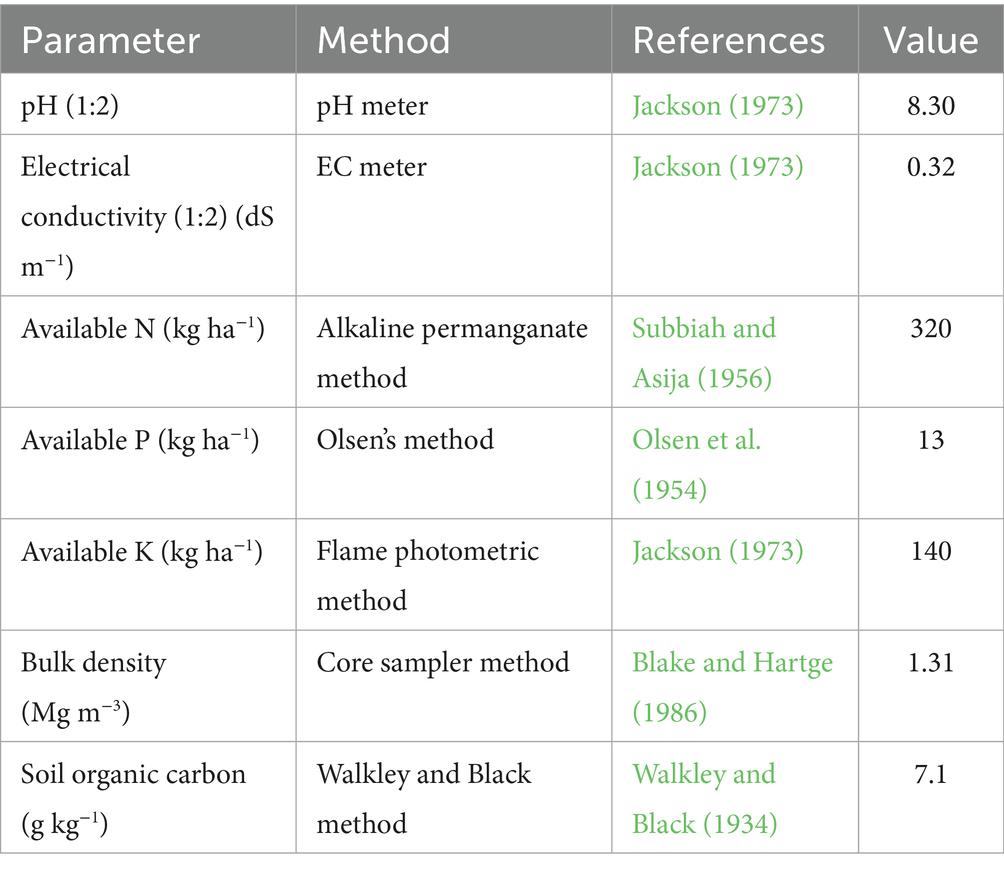- 1Department of Agronomy, Dr. Rajendra Prasad Central Agricultural University, Samastipur, India
- 2Teagasc, Oak Park Crops Research Centre, Carlow, Ireland
- 3Department of Soil Science and Agricultural Chemistry, Bihar Agricultural University, Bhagalpur, India
- 4Department of Soil Science, Dr. Rajendra Prasad Central Agricultural University, Samastipur, India
- 5Department of Plant Production, College of Food and Agriculture Sciences, King Saud University, Riyadh, Saudi Arabia
- 6Department of Biosystems and Agricultural Engineering (BAE), College of Agriculture and Natural Resources, Michigan State University, East Lansing, MI, United States
Conservation agriculture (CA)-based rice-maize cropping system (RMCS) can be the possible option for higher productivity and maintain soil health in the Indo Gangetic Plains. However, weed infestation remains the major constraint in its adoption. Hence, to adopt CA practices and at the same time manage weed population, a field experiment was carried out at Dr. Rajendra Prasad Central Agricultural University during 2019–20 and 2020–21. Treatments consisted of four main plots of different tillage practices, viz. zero- till direct seeded rice followed by zero-till maize (ZTDSR fb ZTM), direct seeded rice followed by maize on permanent raised beds with residue (PBDSR+R fb PBDSM+R), PBDSR followed by PBDSM without residue (PBDSR-R fb PBDSM-R) and conventional tilled puddled transplanted rice followed by conventional tilled maize (CTR fb CTM). On the other hand, sub-plots comprised of five weed management options, viz. unweeded control, vermicompost mulch, P-enriched vermicompost mulch, live mulch and weed-free. The two-year study revealed that the combination of PBDSR+R fb PBDSM+R emerged as the most effective tillage practice, showing a maximum reduction in bulk density (0.07 Mg m−3) and improvements in water holding capacity by 8.1%, soil organic carbon by 8.2%, soil microbial biomass carbon by 32.7%. Among weed management practices, P-enriched vermicompost mulch resulted 18.8% higher dehydrogenase activity of soil with greater nutrient availability as compared to live mulch. In contrast, CTR fb CTM significantly deteriorated soil health. The maximum maize REY (9.3 t ha−1) and system productivity (15.9 t ha−1) were also recorded under PBDSR+R fb PBDSM+R, with increases of up to 15.2 and 25.2% over conventional practices in the second year. Overall, CA practice mainly permanent bed with residue coupled with P-enriched vermicompost mulches demonstrated strong potential for improving soil health and sustainable crop productivity in RMCS.
Highlights
• Soil physical, biological, and chemical properties were improved under CA practices mainly permanent bed with residue (PBDSR+R fb PBDSM+R)
• PBDSR+R fb PBDSM+R increased SOC by 8.2%, WHC by 8.1%, SMBC by 32.7% and system productivity by 25.2% as compared to conventional tillage under RMCS
• P-enriched vermicompost mulch improved soil enzymatic activities and system productivity as compared to conventional hand weeding and other mulching practices
• CTR fb CTM reduced WHC by 6.2%, SOC by 10%, and REY by up to 17.9% over CA practices (PBDSR+R fb PBDSM+R) after 2 years of study
1 Introduction
Rice is the staple food for over half of the global population and in India, rice accounts for 40% of the total food grain production (Pathak et al., 2018). A rice–rice cropping system is usually practiced by farmers where sufficient irrigation is available or in favorable lowland rainfed areas (Shankar et al., 2021). In India, the rice–rice system occupies ~6.0 Mha and is becoming the most dominant cropping practice in South Asia (ICAR-NRRI, 2019); however, due to the continuous practice and adoption of the rice–rice system, several issues related to nutrient imbalance, low nutrient-use efficiency, water stress, energy and labour crisis, high greenhouse gas emissions, and weed management threaten the sustainability of this system (Tuti et al., 2022). Out of 1.5 Mha area under rice-maize cropping system (RMCS) in South Asia, India covers around 0.53 Mha (Jat et al., 2019). Maize is rapidly gaining popularity as a component crop in rice-based systems among farmers in South Asia. These changes are primarily not only due to the increased productivity but also the lucrativeness of maize. Winter maize serves as a promising mitigation option in regions with limited water resources due to its lower water consumption than winter rice. Maize is grown throughout the dry winter months and has a deep tap root structure, therefore it requires less water. Maize uses less water for irrigation than rice, resulting in water saving and increased water efficiency. In both irrigated and rain-fed agricultural settings, maize can be a cost-effective alternative to winter rice (Ondrasek et al., 2014).
Conservation agriculture (CA) is seen as a feasible approach for crop intensification that is both sustainable and profitable. In order to maximize the benefits of CA, location specific appropriate crop rotations and system-based CA strategies must be devised. Furthermore, in order to deal with the burning issue of climate change along with deterioration of soil health, adoption of CA-based tillage practices can be the viable solution (Hailu and Teka, 2024). CA practices characterized by minimal soil disturbance (no-till or reduced tillage), permanent soil cover with crop residues or cover crops, and diversified crop rotations play a pivotal role in enhancing soil health. These practices contribute to improved soil structure, increased organic matter content, and enhanced soil microbial activity, which together promote nutrient cycling and water retention (Ding et al., 2024). Retention of crop residues on the soil surface not only reduces erosion and suppresses weed emergence but also serves as a substrate for beneficial soil microorganisms, thereby increasing microbial biomass and diversity (Hao et al., 2023). Moreover, reduced tillage minimizes soil compaction and preserves soil aggregates, leading to improved soil porosity and aeration, which are critical for healthy root development. Long-term adoption of CA has also been linked with better soil carbon sequestration, enhancing both productivity and resilience of agro-ecosystems under climate stress (Jat et al., 2022). Thus, CA offers a sustainable pathway to restore and maintain soil health while ensuring agricultural productivity. Retention of higher amount of residue along with lower tillage intensity in a cropping system over time sustains soil fertility status (Sharma et al., 2023). The combination of CA with zero tillage (ZT) or minimum tillage and residue retention is preferable for growing maize following rice. The land remains unoccupied from October to the middle of November, i.e., after the harvest of the rice crop in September–October. This is primarily due to the lack of timely sowing of succeeding crops, residual soil moisture constraints, and farmers’ traditional practices of allowing a fallow period for field preparation and weed control. As a result, alternative establishment strategies can be used to change the planting timing of rice in June–July (Tripathi et al., 2025). With the adoption of rice–maize systems, there is ample possibility to adopt CA based practices.
Moreover, apart from the various benefits that have been gained from CA systems, weed control remains a major barrier to its efficiency (Cordeau, 2022). Although surface retention of crop residue in CA-based systems suppresses weed emergence to a certain extent, residues equally restrict mechanical or manual weed control (Sepat et al., 2017). Many studies have reported that modifications in crop establishment from puddled transplanted rice (PTR) to ZT direct seeded rice (DSR) resulted in substantial variations in weed density, weed community composition, and competitiveness with the primary crops. Even though organic weed management strategies such as live mulch and the use of vermicompost are believed to be climate-resilient practice, which offers several benefits such as moisture conservation, weed suppression, improvement of soil health, and sequestration of carbon and nitrogen. However studies are insufficient to substantiate these benefits. Moreover, under the CA-based system, there is a huge application of chemical herbicides, which affects the environment and soil health. Therefore, there is a need to develop some efficient organic weed management strategies under a CA-based system that not only control the weeds but also maintain soil health. A significant amount of research has been directed at understanding the influence of weed management practices under CA-based systems on various crops. However, the integrated effects of these practices have not been thoroughly explored on an individual crop for the long-term. Furthermore, most of the studies in rice-based cropping systems are focused on DSR fb ZT in subsequent crops (Mishra et al., 2024; Shah et al., 2025). Alternative crop establishment techniques like ZTDSR, and DSR in permanent bed with or without residue retention and their comparison with conventional methods under RMCS are important to explore. This will help to understand the best crop management practices to sustain the productivity of rice-based cropping systems along with maintaining soil health.
Based on these facts, the present study investigated the effectiveness of organic weed management practices under CA technologies (ZT with either permanent bed with and without residue retention or with residue retention). The current study aimed to: (a) assess system productivity in response to organic weed management practices under contrasting tillage and residue management regimes in RMCS; (b) evaluate nutrient uptake patterns under organic weed management strategies across different tillage and residue management systems; (c) analyze soil health parameters as influenced by organic weed management practices in various tillage and residue management regimes. The hypothesis of this study was that organic weed management strategies under ZT or residue retention and permanent bed planting would result in higher system productivity and improved soil health as compared with conventional practices in RMCS.
2 Materials and methods
2.1 Experimental site
The field experiment was conducted for 2 years during the kharif (rainy) and rabi (winter) seasons of 2019–20 and 2020–21 at the Crop Research Centre of Dr. Rajendra Prasad Central Agricultural University (located 20° 58′N, 85° 40′E, at an elevation of 173 m above the mean sea level), Pusa. The climate of the experimental site is characterized by a hot sub-humid (moist) eco-region that experiences cold and dry winters, and hot and humid summers. The weather data was recorded at meteorological observatory located at RPCAU, Pusa. The mean annual rainfall is 1,344 mm and its distribution is unimodal, 70% of which is received between July and September. The quantity of rainfall received during the experimental years was inconstant and was 1,046 and 1,327 mm during 2019–20 and 2020–21, respectively. January recorded the lowest mean minimum temperature of 9.4°C in both years. During the 2019–20 cropping cycle, June had the highest maximum temperature of 37.5°C, whereas in the cropping year 2020–21, April was the hottest month with a maximum temperature of 35.8°C. Soil sampling was done from 0 to 15 cm layer using a steel auger of 5.0 cm internal diameter at the start of the experiment in May 2019. The soil was clay loam in texture and initial physico-chemical properties of the soil are mentioned in Table 1. The initial soil was medium in soil organic carbon, available N, P and K.
2.2 Experimental design and treatment
The experiment was conducted in a split plot design in plot of size 6 m × 2.6 m with four main plot treatments and five sub plot treatments each replicated thrice. In the main plot there were different tillage and residue management practices and in sub-plots organic weed management practices were undertaken in a rice-maize rotation (Table 2). The recommended dose of fertilizer (N: P: K: Zn) for rice (cv. Rajendra Mahsuri) and maize (cv. DKC 9081) was 150: 26: 17.5: 10 kg ha−1 and 200: 35: 26: 10 kg ha−1, respectively.
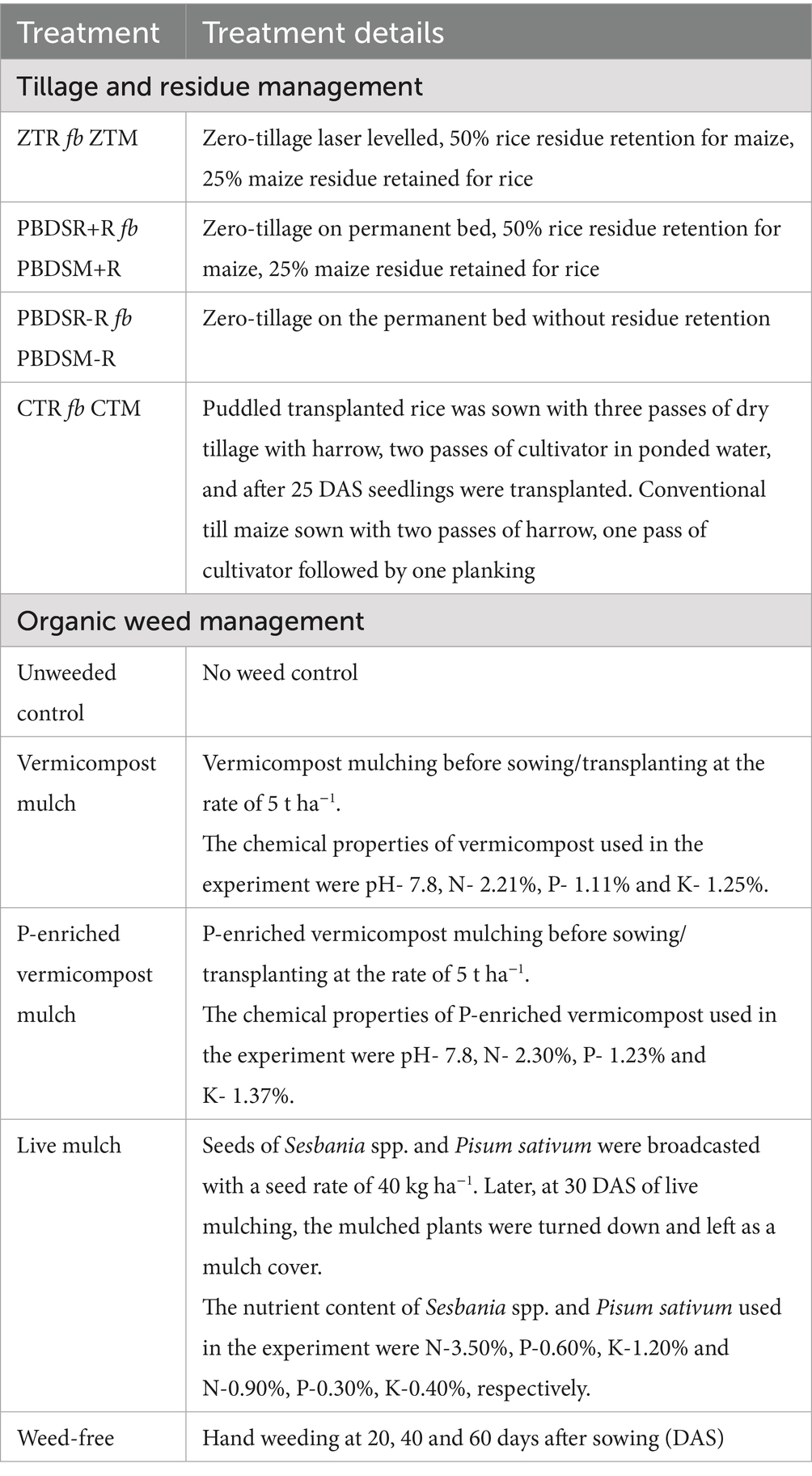
Table 2. Description of organic weed, tillage and residue management practices under rice-maize rotation.
2.3 Soil sampling and analysis
Soil sampling was done in the experimental plot at a depth of 0–15 cm before and after completion of 2 years of the experiment (Page et al., 1982). The samples collected from the plots were air dried in shade. Later, the samples were passed through 2 mm sieve after grinding and stored in plastic bags for further analysis (Jackson, 1973). Moreover, for biological studies, soil clumps were stored in the refrigerator at 4 ± 1°C for 7 days (Alef et al., 1995). The standard methodology was followed for the laboratory analysis of the processed soil samples.
2.3.1 Soil physicochemical properties
Bulk density (BD) was determined by the core sampler followed by oven-drying at 105°C for 24 h. Oven-dried soil weight was divided by the known volume of the core to determine the BD as described by Blake and Hartge (1986). The water-holding capacity of the soil was determined using the gravimetric method. Soils were collected in the known weight, uniform volume soil–moisture boxes, and the moist–soil weight was taken; afterwards, the soils in the moisture box were oven dried at 105 ± 2°C. Then, the dry weight was taken to know the weight of the moisture kept in the soil.
Soil pH was determined from the soil: water suspension (in 1:2 ratio) as described by Jackson (1973). The soil organic carbon (SOC) was determined by the wet combustion method (Walkley and Black, 1934). The available N was determined by the alkaline permanganate method as per procedure suggested by Subbiah and Asija (1956), available P by the method given by Olsen et al. (1954), and available K was measured by the neutral normal ammonium acetate method given by as described by Jackson (1973). Cation exchange capacity (CEC) of soil was determined by Neutral normal ammonium acetate method (Jackson, 1973).
2.3.2 Soil biological properties
Soil microbial biomass carbon (SMBC) was determined by chloroform fumigation-extraction technique following the method of Vance et al. (1987). Soil respiration was estimated using the method as described by Zibilske (1994). Soil metabolic quotient (qCO2) is the ratio of soil respiration to SMBC content was as described by Anderson and Domsch (2010). Soil dehydrogenase activity (DHA) was determined by the reduction of triphenyltetrazolium chloride (TTC) to triphenylformazan (TPF) as described by Casida et al. (1964). The method of Tabatabai and Bremner (1969) was followed to estimate the alkaline phosphatase activity (APA).
2.4 System studies
2.4.1 Weed dry weight
Weed dry weight was recorded in each growing season at 30 DAS of rice and maize using a quadrat method. A 0.5 m × 0.5 m quadrat was randomly placed at two locations per plot to sample aboveground weed biomass. All weeds within the quadrat were carefully uprooted, washed to remove soil particles, and air-dried to remove surface moisture. The samples were then oven-dried at 65 ± 2°C until constant weight was achieved. The dried biomass was weighed using a digital balance, and the mean weed dry weight was expressed in g m−2 of each RMCS.
2.4.2 Rice equivalent yield
Rice equivalent yield (REY) was calculated by using following formula:
2.4.3 System productivity
System productivity of rice-wheat cropping system was calculated by adding rice yield and rice equivalent yield of wheat and reported as kg ha−1.
2.5 Statistical analysis
All the data recorded in this study were statistically analyzed as per the protocol of split-plot design using the software package of R (R Core Team, 2022). Two-way analysis of variance (ANOVA) was used to examine the effects of the treatments on various parameters, and the treatment means were compared employing the least significant difference (LSD) tests with a 5% level of probability (p = 0.05) among the treatments (Gomez and Gomez, 1984). The principal component bi-plot analysis has been done for the post-harvest soil after 2 years of RMCS and correlation study has been done for mean of 2 years using the R 4.3.1 software. The differences among treatment means were adjudged by Duncan’s Multiple Range Test (DMRT) (Gomez and Gomez, 1984).
3 Results
3.1 Soil physico-chemical properties
Soil physical properties varied significantly due to various tillage and organic weed management practices. The maximum reduction of 0.07 Mg m−3 in BD in comparison to initial was found with PBDSR+R fb PBDSM+R (Table 3). However, adoption of CTR fb CTM increased the BD by 4.6% as compared to the initial. Application of P- enriched vermicompost mulch reduced the BD by 5.3% in comparison to the initial. On the other hand, vermicompost mulch showed a decrease in BD by 3.8% over initial BD (Table 3). Water holding capacity was found maximum under PBDSR+R fb PBDSM+R and it showed an increase of 4.3 and 8.1% as compared to the PBDSR-R fb PBDSM-R and CTR fb CTM, respectively (Table 3). Adoption of CTR fb CTM resulted in a decline of 6.2% (33.2%) in water holding capacity than ZTR fb ZTM (35.3%). Among different organic weed management practices, the minimum water holding capacity of 34.88% was found with live mulch while P-enriched vermicompost mulch resulted in 2.1% increase in water holding capacity than vermicompost mulch.
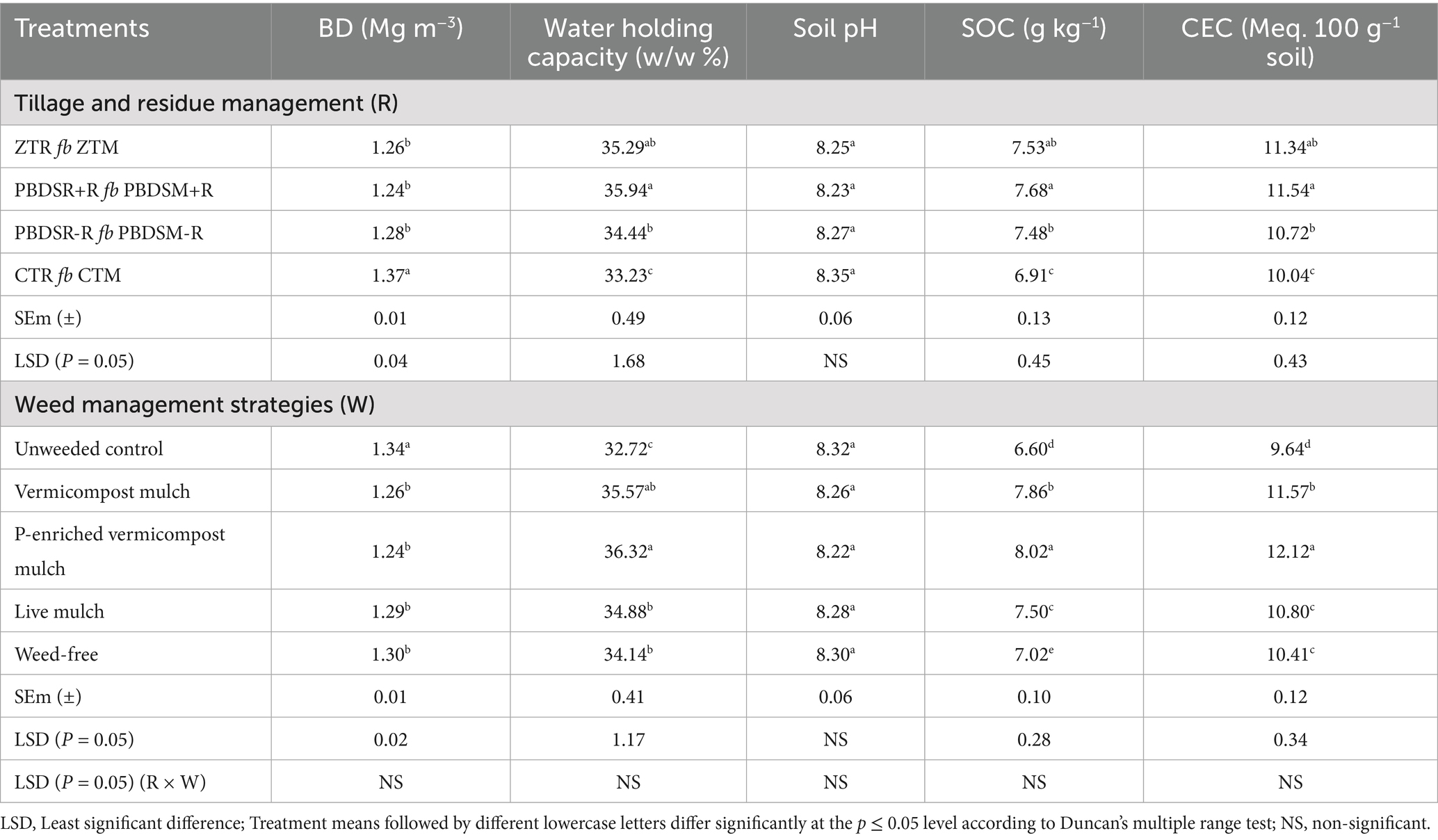
Table 3. Effect of CA practices and organic weed management strategies on soil physico-chemical properties after 2 years of study under RMCS.
Different tillage and organic weed management strategies did not showed a significant effect on soil chemical properties. The lowest soil pH as compared to the initial was found with PBDSR+R fb PBDSM+R. However, adoption of CTR fb CTM resulted in slight increase in soil pH than initial (Table 3). Application of P-enriched vermicompost mulch showed maximum reduction in soil pH (8.22) as compared to the initial (8.30). Adoption of PBDSR+R fb PBDSM+R resulted in maximum SOC (7.68 g kg−1) which was 8.2% higher as compared to the initial (7.10 g kg−1). On the other hand, CTR fb CTM showed a decline of 10.0 and 8.2% in SOC over PBDSR-R fb PBDSM-R and ZTR fb ZTM, respectively. Application of P-enriched vermicompost mulch recorded maximum SOC which was 2.0 and 6.9% more as compared to vermicompost mulch and live mulch, respectively (Table 3). The maximum CEC was found with PBDSR+R fb PBDSM+R which was 7.6 and 14.9% higher as compared to PBDSR-R fb PBDSM-R and CTR fb CTM, respectively. A decline in CEC by 1.8% was found with ZTR fb ZTM (11.34 Meq. 100 g−1 soil) soil over PBDSR+R fb PBDSM+R (11.54 Meq. 100 g−1 soil). Among different organic weed management practices, application of live mulch showed a decrease of 6.6 and 10.9% in CEC as compared to vermicompost mulch and P-enriched vermicompost mulch, respectively (Table 3).
3.2 Nutrient availability in soil
Soil available N was found highest under PBDSR+R fb PBDSM+R (357 kg ha−1) which was 9.5 and 2.3% higher than PBDSR-R fb PBDSM-R and ZTR fb ZTM, respectively (Table 4). The minimum available N of 272 kg ha−1 was with CTR fb CTM after 2 years of study. Among different weed management strategies, application of P-enriched vermicompost mulch resulted in an increase of 3.7 and 5.8% in available N over vermicompost mulch and live mulch, respectively. Similarly, adoption of PBDSR+R fb PBDSM+R resulted in highest available P (35.8 kg ha−1) which was 19.3 and 23.0% more in comparison to PBDSR-R fb PBDSM-R and CTR fb CTM, respectively. Furthermore, CTR fb CTM showed decline of 14.4% in available P over ZTR fb ZTM (Table 4). Among various organic weed management practices, live mulch recorded a decrease of 4.8 and 9.2% than vermicompost mulch and P-enriched vermicompost mulch, respectively. Available K was maximum under PBDSR+R fb PBDSM+R (206 kg ha−1) showing an increase of 32.1% as compared to PBDSR-R fb PBDSM-R. On the other hand, CTR fb CTM showed decrease of 22.0% (149 kg ha−1) in available K over ZTR fb ZTM (191 kg ha−1). Application of P- enriched vermicompost mulch enhanced the available K by 13.0% than live mulch (Table 4).
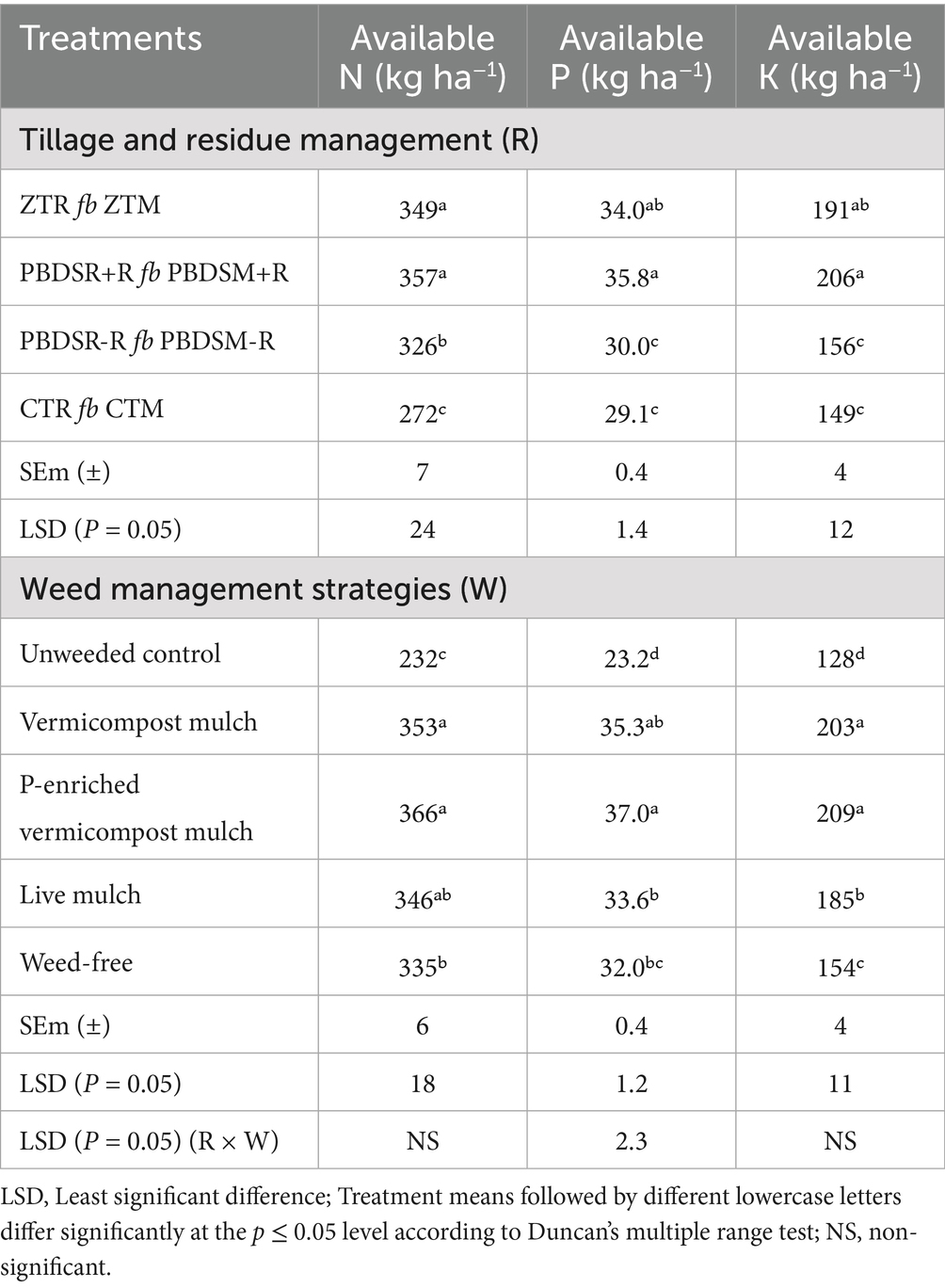
Table 4. Nutrient availability in post-harvest soil as affected by CA practices and organic weed management strategies after 2 years of study under RMCS.
3.3 Soil biological properties
Different soil biological properties, i.e., SMBC, soil respiration and soil metabolic quotient varied significantly with different tillage and organic weed management practices (Table 5). Under different tillage practices, adoption of PBDSR+R fb PBDSM+R (446 mg kg−1 soil) showed an increase of 32.7 and 6.7% in SMBC as compared to CTR fb CTM and ZTR fb ZTM, respectively. Among various organic weed management practices, application of P-enriched vermicompost mulch resulted in maximum SMBC (499 mg kg−1 soil) which was 13.9% more as compared to live mulch after 2 years of the study. Furthermore, soil respiration was found maximum under PBDSR+R fb PBDSM+R (2.01 mg CO2 g−1 soil h−1) which was 4.7 and 22.5% higher in comparison to PBDSR-R fb PBDSM-R (1.97 mg CO2 g−1 soil h−1) and CTR fb CTM (1.92 mg CO2 g−1 soil h−1) respectively. In case of organic weed management strategies, similar trend has been followed like SMBC; where live mulch resulted in a decrease of 3.9% in soil respiration as compared to P-enriched vermicompost mulch (Table 5). Among various tillage practices, lowest soil metabolic quotient was found with PBDSR+R fb PBDSM+R while ZTR fb ZTM showed a decline of 4.1% in soil metabolic quotient over CTR fb CTM after 2 years of the study under RMCS. Unweeded control resulted in highest soil metabolic quotient (5.44 mg CO2 g−1 microbial C h−1) which was 27.4 and 16.0% higher as compared to P-enriched vermicompost mulch (4.27 mg CO2 g−1 microbial C h−1) and live mulch (4.69 mg CO2 g−1 microbial C h−1) respectively (Table 5).
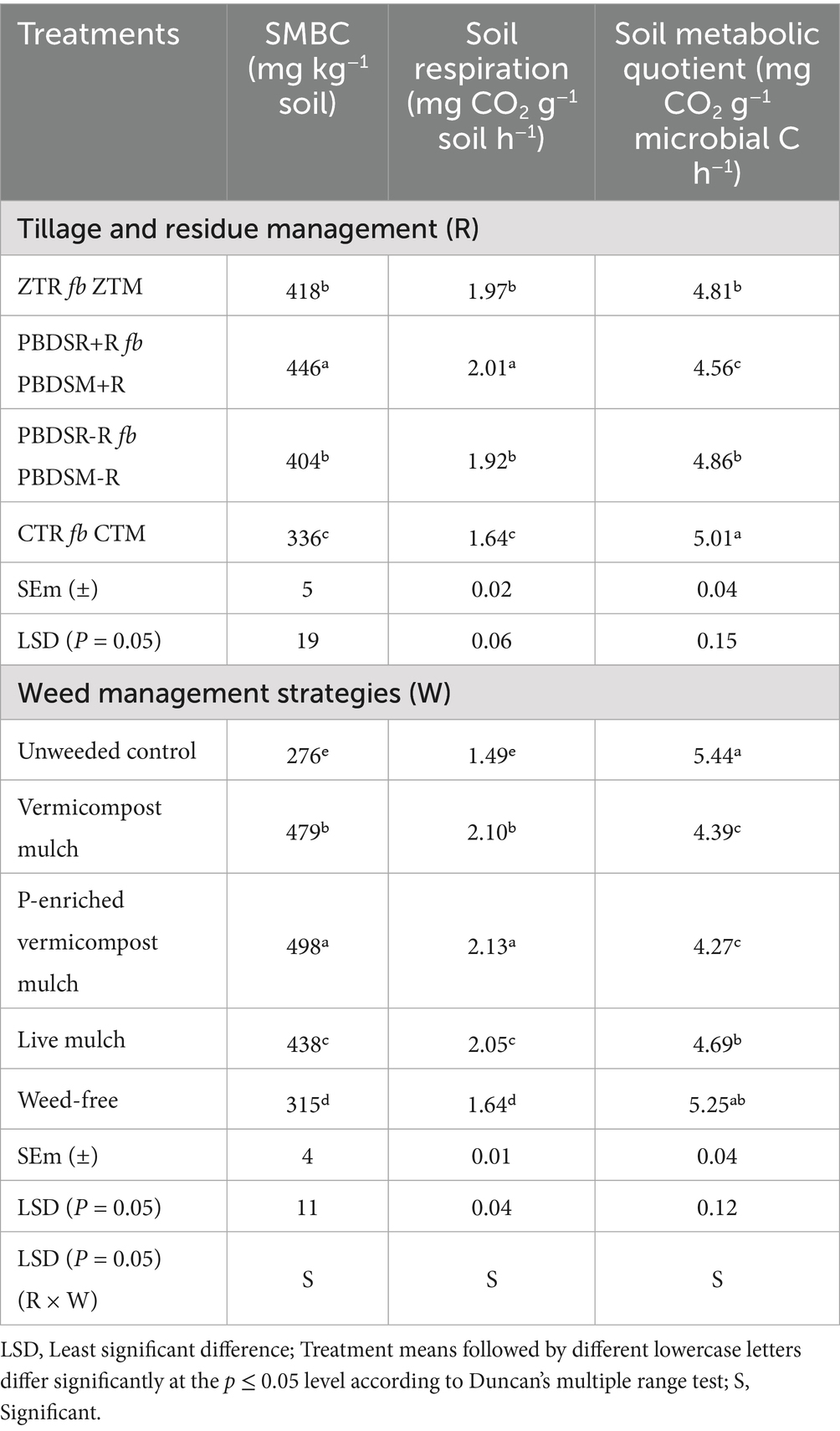
Table 5. Influence of CA practices and organic weed management strategies on biological properties of post-harvest after 2 years of study under RMCS.
3.4 Soil enzymatic activity
Soil enzymes were significantly influenced by the varied tillage and organic weed management practices (Figures 1, 2). Under different tillage practices, the adoption of PBDSR+R fb PBDSM+R resulted in an increase of 14.4% in DHA over CTR fb CTM after 2 years of study under RMCS (Figure 1). Application of P-enriched vermicompost mulch showed maximum DHA which was 3.6 and 18.8% higher than vermicompost mulch and live mulch, respectively. After 2 years of the experiment, adoption of CTR fb CTM resulted in minimum APA, i.e., 10.4% lower as compared to PBDSR+R fb PBDSM+R (Figure 2). The highest APA of 176.6 μg PNP g−1 soil h−1 was found with P-enriched vermicompost mulch under various organic weed management practices. Application of live mulch showed a decline of 7.8% in APA over P-enriched vermicompost mulch.
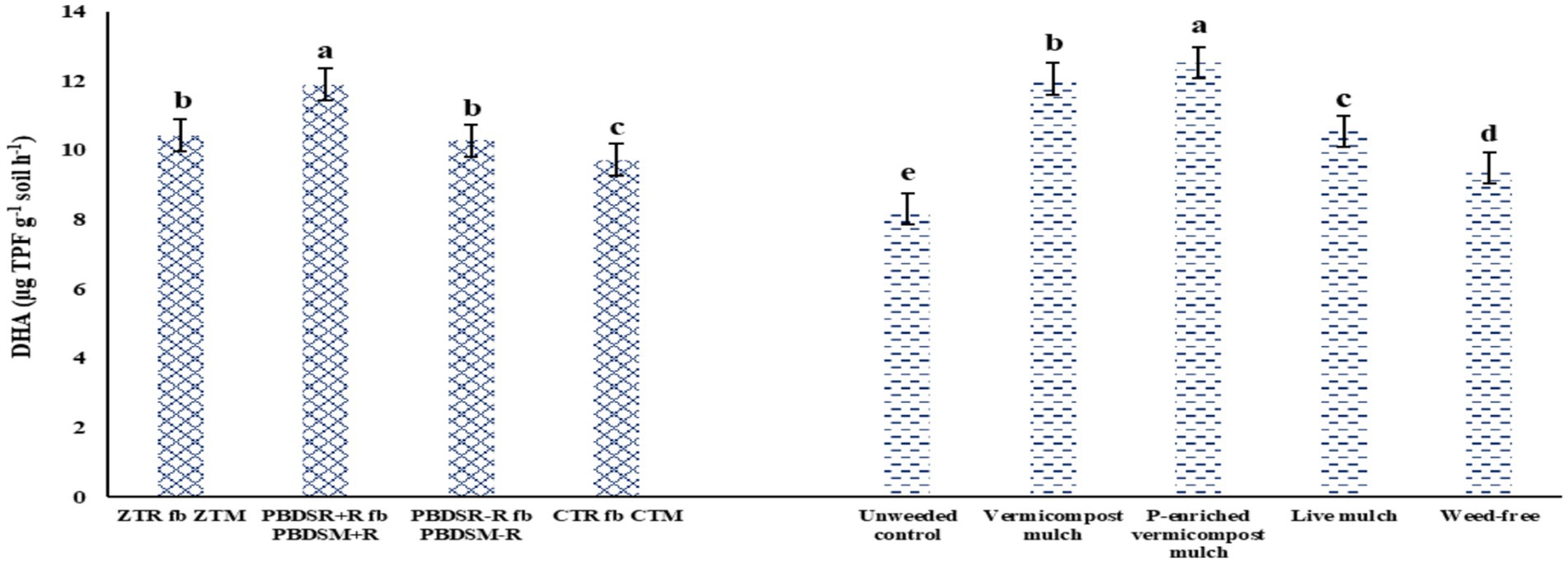
Figure 1. Impact of CA practices and organic weed management strategies on dehydrogenase activity (DHA) of post-harvest soil after 2 years of study under RMCS. Treatment means followed by different lowercase letters differ significantly at the p ≤ 0.05 level according to Duncan’s multiple range test.
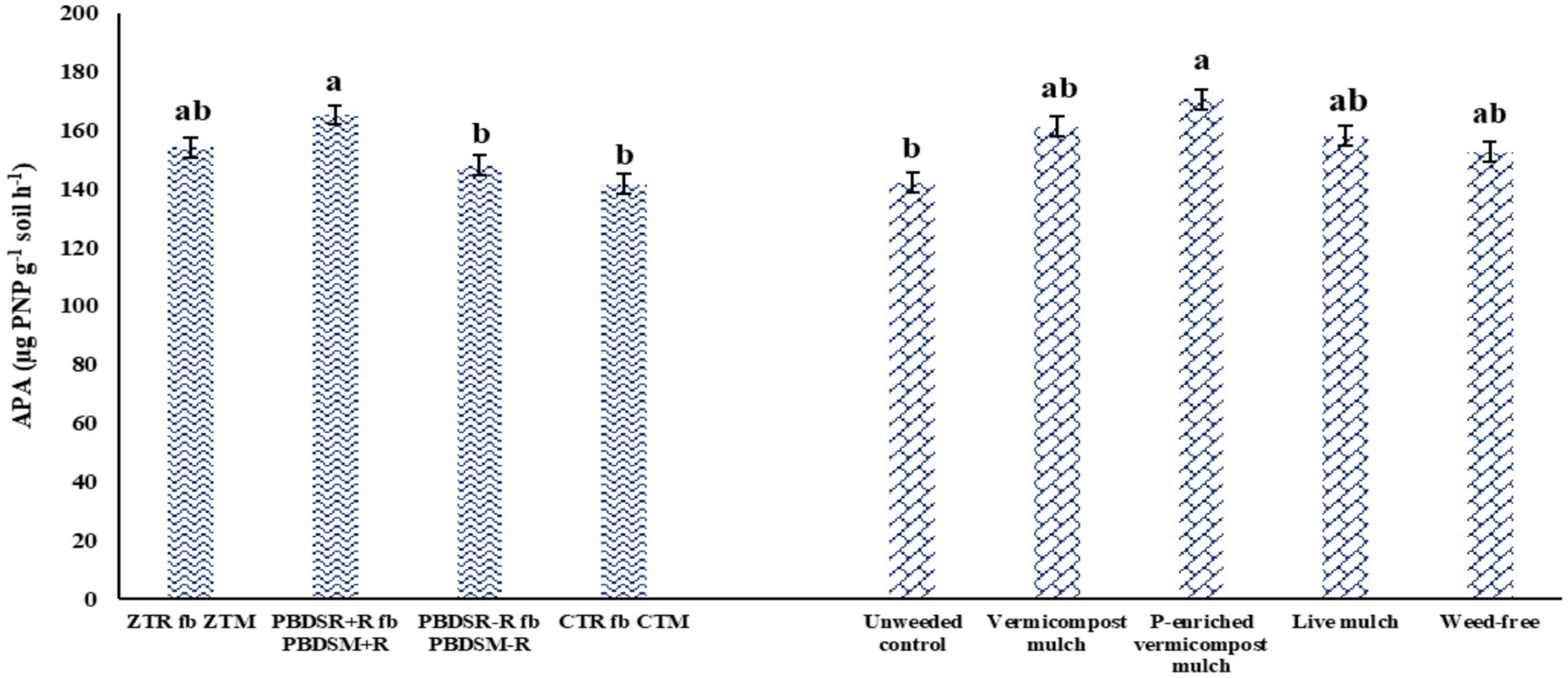
Figure 2. Alkaline phosphatase activity (APA) of post-harvest soil as affected by CA practices and organic weed management strategies under RMCS. Treatment means followed by different lowercase letters differ significantly at the p ≤ 0.05 level according to Duncan’s multiple range test.
3.5 Weed dry weight
Weed dry weight at 30 DAS was significantly influenced by tillage and residue management practices as well as weed management strategies across both years (Table 6). Among the tillage treatments, PBDSR+R fb PBDSM+R recorded the lowest weed dry weight (5.42 and 5.13 g m−2 during 2019–20 and 2020–21, respectively), which was 17.9 and 20.0% lower than that observed in CTR fb CTM (6.61 and 6.41 g m−2, respectively). Compared to PBDSR-R fb PBDSM-R, weed dry weight under PBDSR+R fb PBDSM+R was 11.7 and 12.5% lower in 2019–20 and 2020–21, respectively. Conversely, the highest weed dry weight was recorded under CTR fb CTM, which was 13.9 and 16.1% higher than ZTR fb ZTM, respectively.
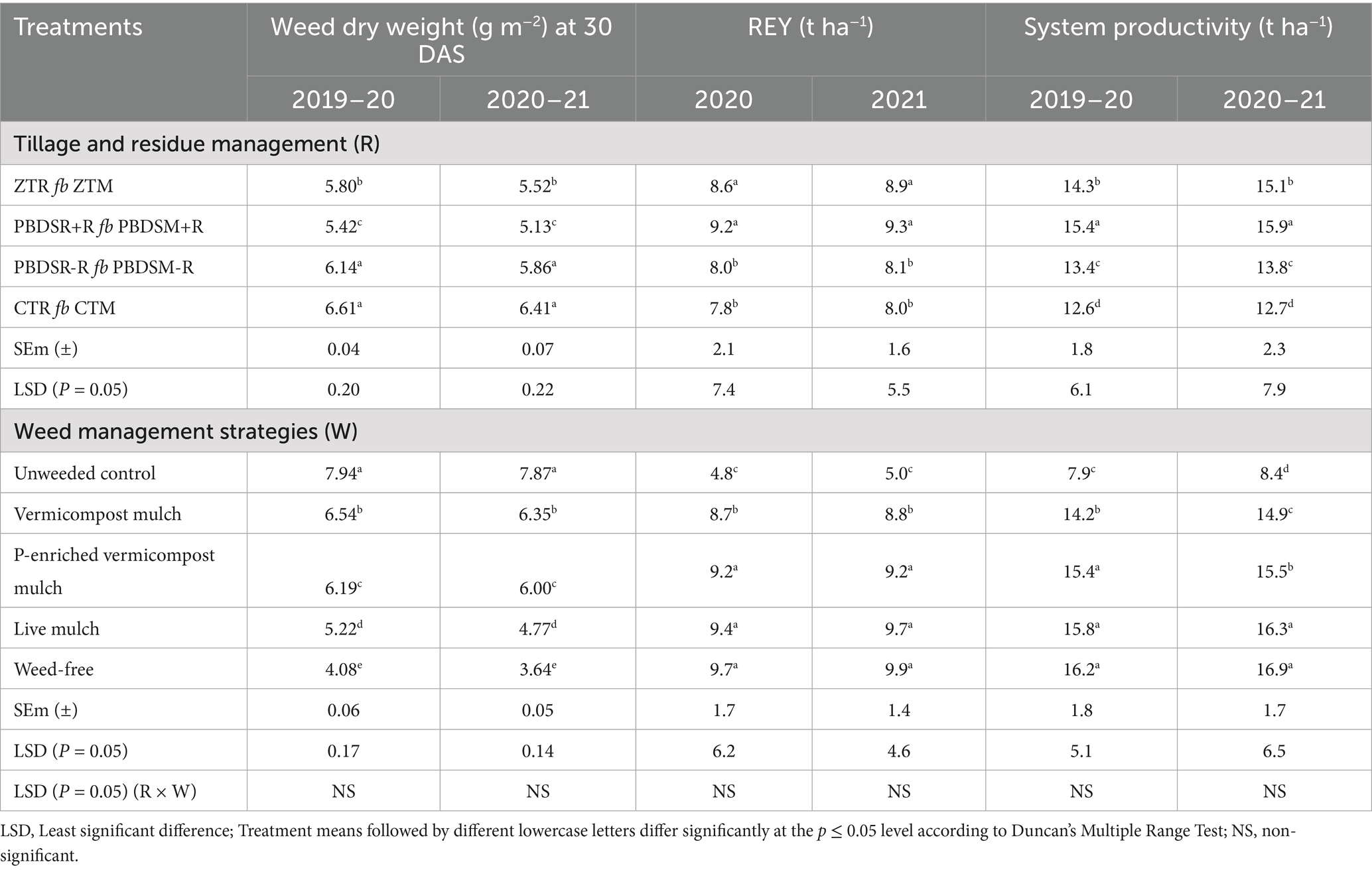
Table 6. Dry weight of weed at 30 DAS, REY of maize and system productivity as influenced by CA-based tillage practices and organic weed management in RMCS.
Under weed management strategies, the weed-free treatment resulted in the minimum weed dry weight (4.08 and 3.64 g m−2), which was 48.6 and 53.7% lower than the unweeded control (7.94 and 7.87 g m−2), respectively. Among organic options, live mulch significantly reduced weed dry weight as compared to other mulches, representing a 20.2 and 24.8% reduction as compared to P-enriched vermicompost mulch, and 36.1 and 34.7% reduction compared to vermicompost mulch, respectively (Table 6). Notably, live mulch inspite of not having better soil health but showed highest system productivity and REY due to low weed biomass during the critical crop weed completion period (30 DAS).
3.6 System productivity
Different CA practices and organic weed management strategies significantly influenced the REY of maize during both the years of the study. Adoption of PBDSR+R fb PBDSM+R resulted in maximum REY of maize which was 15 and 14.8% higher than PBDSR-R fb PBDSM-R in 2019 and 2020, respectively (Table 6). Among various organic weed management practices, application of live mulch showed an enhancement of 8.0 and 10.2% in REY of maize over vermicompost mulch in first and second year of the study, respectively.
System productivity, which refers to the overall efficiency and output of a cropping system, was found to be highest in PBDSR+R fb PBDSM+R during both the years of the experiment. During the first year of the experiment, a decline of 10.2 and 17.9% in REY was found with adoption of CTR fb CTM as compared to ZTR fb ZTM and PBDSR+R fb PBDSM+R, respectively. Furthermore, PBDSR+R fb PBDSM+R resulted in an enhancement of 15.2 and 25.2% in system productivity as compared to PBDSR-R fb PBDSM-R and CTR fb CTM in 2020–21, respectively. During both the years of the experiment, live mulch showed highest system productivity but P-enriched vermicomost produced 2.6 and 4.0% more than vermicompost mulch during 2019–20 and 2020–21, respectively. However, there was no interaction effect between tillage and organic weed management on the system productivity of RMCS. The superior performance of live mulch in system productivity, despite exhibiting lower biological indicators compared to P-enriched vermicompost, can be attributed to several complementary mechanisms. Live mulch likely provided more effective weed suppression through physical ground coverage which led to lower weed biomass, reducing inter-crop competition for nutrients, water, and light. Additionally, the continuous photosynthetic activity of live mulch may have contributed to atmospheric nitrogen fixation and enhanced microclimate moderation, creating favorable conditions for crop growth.
3.7 Principal component analysis
Principal component analysis of different soil parameters with CA practices and organic weed management strategies showed that on the right side P-enriched vermicompost (PVM), PBDSR+R fb PBDSM+R (PBR), and vermicompost mulch (VM) are strongly associated with improved soil health indicators viz. higher SOC, CEC, available water content (WHC), and SMBC (Figure 3). Therefore, it is proved that these CA and weed management practices are more sustainable. Conversely, treatments on the left (unweeded, CT, weed-free) appear to have poorer soil quality indicators but higher pH and bulk density. Therefore, the princi results suggest that CA based management practices with P-enriched vermicompost mulch have a dramatic effect on soil properties, with PC1 explaining over 90% of the variation, indicating a strong, consistent pattern across the measured soil health parameters under RMCS (Figure 3).
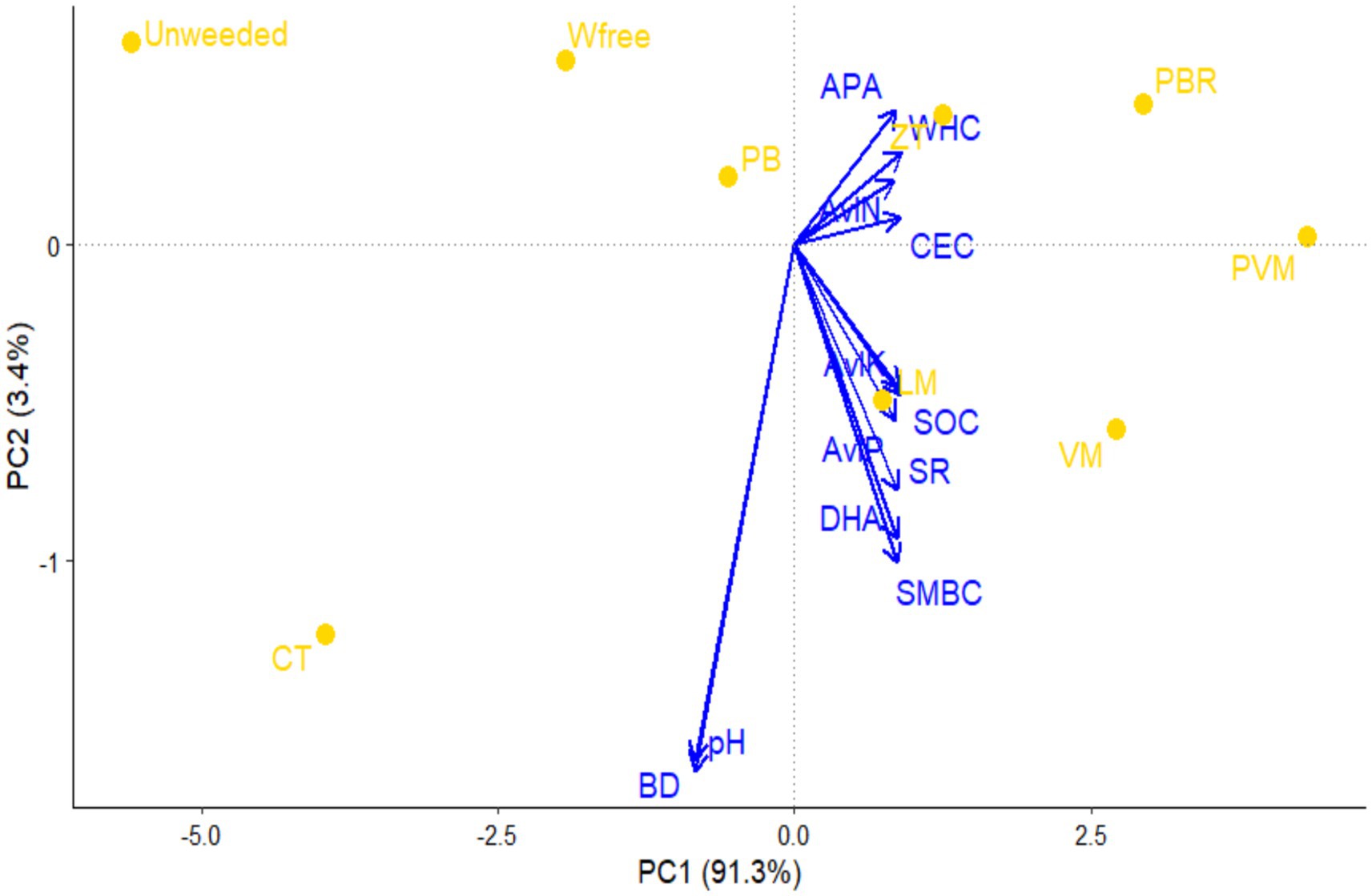
Figure 3. Principal component analysis of different soil parameters with CA practices and organic weed management strategies under RMCS. ZT, ZTR fb ZTM; PBR, PBDSR+R fb PBDSM+R; PB, PBDSR-R fb PBDSM-R; CT, CTR fb CTM; VM, vermicompost mulch; PVM, P-enriched vermicompost mulch; LM, live mulch; Wfree, weed free; BD, bulk density; WHC, water holding capacity; SOC, soil organic carbon; CEC, cation exchange capacity; AvlN, soil available N; AvlP, soil available P; AvlK, soil available K; SMBC, soil microbial biomass carbon; SR, soil respiration; DHA, dehydrogenase activity; APA, alkaline phosphatase activity.
4 Discussion
4.1 Soil physico-chemical properties
The adoption of PBDSR+R fb PBDSM+R resulted in the lowest BD among all tillage and crop establishment practices. In contrast, the highest BD was recorded under CTR fb CTM, which may be attributed to puddling-induced compaction caused by the repeated use of machinery during tillage operations, potentially leading to increased BD (Orzech et al., 2021). However, some researchers have reported higher BD values under the ZT system, particularly in clay or silty loam soils (Ghimire et al., 2017; Das et al., 2022). Mondal et al. (2019) observed that bulk density was consistently lower under zero-tillage and residue management systems compared to conventional practices. Additionally, the incorporation of higher crop biomass and residue recycling enhances the organic matter content in the soil, contributing to greater SOC levels, which in turn promote soil aggregation and reduce BD under PBDSR+R followed by PBDSM+R (Shaukat et al., 2023). The observed reduction in BD under P-enriched vermicompost may also be associated with elevated SOC levels, likely because minerals are denser than organic matter, and the presence of organic matter enhances soil aggregation and porosity (Balík et al., 2025). CA practices maintained higher soil moisture and WHC due to increased infiltration and residue cover (Parihar et al., 2020; Mondal et al., 2019). Moreover, crop residues can influence soil temperature, reducing evaporative water loss and thereby improving soil moisture retention (Roper et al., 2021). Abdallah et al. (2021) similarly reported that the incorporation of organic matter modifies micro-porosity, decreases soil penetration resistance, and increases the water holding capacity of the soil.
Organic weed management practices significantly influenced several key soil physical and chemical properties. Among these strategies, the application of P-enriched vermicompost mulch consistently outperformed other treatments, particularly in improving soil structure and nutrient availability. A notable reduction in BD was observed with P-enriched vermicompost mulch, which showed a 5.3% decrease compared to the initial BD, whereas standard vermicompost mulch led to a 3.8% reduction. This reduction can be attributed to improved soil aggregation and porosity facilitated by the higher organic matter input from vermicompost, which enhances microbial activity and structural stability (Aksakal et al., 2016; Siedt et al., 2021). The superior performance of vermicompost-based mulches may be due to their higher capacity to retain water through improved soil texture and organic matter content, which enhances soil porosity and capillarity (Oyege and Balaji Bhaskar, 2023).
Our results showed that among the various tillage practices, the lowest pH was observed under PBDSR+R fb PBDSM+R. This may be attributed to the acidifying effect resulting from the mineralization of organic matter and root exudation. The reduction in soil pH is generally a short-term effect, primarily caused by two factors: the production of organic acids during the decomposition of crop residues and microbial respiration (Lei et al., 2023). Additionally, among the organic weed management strategies, the application of P-enriched vermicompost mulch led to the lowest soil pH. This could be due to the decomposition of vermicompost components, which release various organic acids that contribute to pH reduction, along with the emission of carbon dioxide that reacts with water to form carbonic acid (Katiyar et al., 2023). Furthermore, the combination of mineral fertilizer with vermicompost may have created favorable conditions and an energy source for microbial activity, enhancing acid secretion and further lowering the soil pH (Blouin et al., 2019). Although overall differences among tillage and weed management treatments were not statistically significant, meaningful trends emerged. The maximum reduction in soil pH (from 8.30 to 8.22) occurred under P-enriched vermicompost mulch. This slight acidification could be due to the release of organic acids during the decomposition of vermicompost, which may improve nutrient solubility and availability. P-enriched vermicompost increases soil pH by neutralizing acidity. This happens because phosphate ions displace acidic cations like H+ and Al3+ in the soil exchange complex, leading to a moderate rise in pH especially in acidic soils (Bekele et al., 2018). The buffering capacity introduced by phosphorus compounds also contributes to stabilizing soil pH, which can create a more favorable environment for nutrient availability and root growth.
CA practices had a significant effect on the concentration of organic carbon in soil. The results indicated that SOC was higher under PBDSR+R fb PBDSM+R as compared to CTR fb CTM. This could be attributed to the fact that intensive tillage operations lead to greater losses of SOM and accelerated soil degradation. Under CA tillage practices, organic matter decomposition rates are lower, which results in increased organic carbon and total SOC in the soil (Ahmad et al., 2024). Each tillage practice involves soil disturbance, which contributes to a decline in the decay rate of organic matter, subsequently reducing SOM levels. CA practices have been shown to improve the labile pools of SOC, with ZT significantly enhancing labile SOC pools more than CT practices. The elevated SOC observed in P-enriched vermicompost plots may be associated with the higher organic carbon content of vermicompost, which serves as an energy source for microorganisms responsible for decomposition (Oyege and Balaji Bhaskar, 2023). P-enriched vermicompost mulch also resulted in enhanced SOC is likely due to the high organic carbon input from enriched vermicompost, which not only adds to the soil carbon pool but also stimulates microbial decomposition processes that stabilize organic matter (Romaniuk et al., 2011; Oyege and Balaji Bhaskar, 2023).
The addition of PBDSR+R fb PBDSM+R significantly contributes to the improvement of soil health by positively influencing both pH and SOC. The retention of rice and maize residues on permanent beds leads to the gradual decomposition of organic matter, releasing organic acids that help buffer the soil pH and maintain it within an optimal range. Moreover, the continuous input of crop residues, coupled with reduced soil disturbance under permanent bed systems, contributes to the accumulation of SOC (Jat et al., 2022). This increase in SOC improves soil structure, enhances porosity, and boosts water-holding capacity. It also supports the proliferation of beneficial microorganisms and enhances enzymatic activity, which collectively improve nutrient mineralization and availability (Pramanick et al., 2024). As a result, the PBDSR+R fb PBDSM+R system promotes a biologically active, chemically balanced, and physically stable soil environment, which is crucial for sustainable crop production and long-term soil health.
Crop residue management had a strong and significant impact on the soil’s CEC. Findings indicated that PBDSR+R fb PBDSM+R, along with the application of P-enriched vermicompost mulch, resulted in the highest CEC. This is likely due to the accumulation of SOM from crop residues, which contributes negative charges that enhance CEC (Fu et al., 2021). Crop residue retention played a central role in the treatments that increased CEC over the short term. Previous studies have also reported an increase in CEC following crop residue retention (Shankar et al., 2021). These results underscore the sensitivity of CEC to changes in crop residue management. The highest CEC was recorded with P-enriched vermicompost mulch among different weed management strategies, this may be attributed to the increased negative charges contributed by humified organic matter from vermicompost, which enhances the soil’s capacity to retain and exchange essential nutrients (Pan and Huang, 2024). Furthermore, CEC of soil is significantly improved by P-enriched vermicompost. The enrichment process often involves the addition of phosphate-bearing minerals, which increase the number of negative charge sites on organic matter. These sites can adsorb more cations like NH₄+, K+, Ca2+, and Mg2+, thereby improving nutrient retention (Chakraborty et al., 2024). This contributes to better soil fertility and sustained nutrient availability over time.
The study also revealed that the highest levels of available N, P, and K were recorded under PBDSR+R fb PBDSM+R, while the lowest were observed under CTR followed by CTM. This can be explained by the lower nitrogen uptake by crops in PBDSR+R followed by PBDSM+R, leaving a greater amount of non-labile nitrogen in the soil pool compared to CTR followed by CTM. Residue retention helps to maintain optimal soil temperature and moisture conditions, facilitating organic matter decomposition and nutrient cycling, which ultimately enhance nitrogen availability (Dutta et al., 2022). The increased availability of phosphorus under permanent bed direct seeding with or without residue retention may be due to the build-up of extractable phosphorus in PBDSR+R relative to PBDSM+R (Saurabh et al., 2021). In residue-retained plots, reduced P adsorption onto mineral surfaces enhances P availability compared to CTR followed by CTM. Moreover, permanent beds with residue retention promote the formation of stable complexes between P-fixing ions (Ca2+, Fe3+, and Al3+) and soil organic matter, which increases soil P availability (Pradhan et al., 2011). The production of organic acids and the reduction in soil pH during crop residue decomposition are mechanisms that help release fixed P, making it accessible to plants. Similarly, PBDSR+R fb PBDSM+R resulted in the highest levels of available potassium. The lower K values under CTR followed by CTM may be attributed to the absence of residue return, unlike in ZTR followed by ZTM and PBDSR+R fb PBDSM+R. Furthermore, continuous K removal through crop uptake contributes to a further reduction in available K. The decomposition of crop residues retained under PBDSR+R fb PBDSM+R likely increased K availability. In addition, a significant portion of potassium remained in equilibrium and was replenished through desorption from fixed forms in soil and clay micelles into the soil solution (Awgchew et al., 2024).
Among weed management strategies, the increase in available N in P-enriched vermicompost can be linked to the slow mineralization of nitrogen-rich organic inputs, enhancing soil N reserves (Shyam et al., 2023). Similarly, available phosphorus was highest with P-enriched vermicompost mulch, with values 4.8 and 9.2% greater than those of vermicompost and live mulch, respectively. This improvement is likely due to both the direct addition of P from the enriched material and the role of organic acids in enhancing P solubility (Li et al., 2019). In the case of available potassium, the higher K levels in the same may be explained by the potassium-rich nature of the composted material and the desorption of fixed K from clay minerals enhanced by organic inputs (Belda et al., 2013; Wang et al., 2021). Overall, the findings suggest that among the evaluated organic weed management strategies, P-enriched vermicompost mulch is the most effective in enhancing soil physical and chemical properties, thus contributing to improved soil health and fertility. Soil available N is enhanced in P-enriched vermicompost because phosphorus supports microbial growth, which in turn accelerates the mineralization of organic nitrogen into plant-available forms such as ammonium (NH₄+) and nitrate (NO₃−) (Sande et al., 2024). Additionally, phosphorus enrichment helps balance the C: N: P ratio, thereby reducing nitrogen immobilization and enhancing net nitrogen release into the soil solution. On the other hand, soil available K is improved in P-enriched vermicompost not only due to microbial decomposition of organic material but also because some P sources (like rock phosphate) contain trace amounts of K (Das et al., 2022). Enhanced microbial activity further contributes to the rapid mineralization of K-bearing organic matter, making more K+ ions available for plant uptake. The increased CEC also helps reduce potassium leaching by retaining K+ on soil colloids.
4.2 Soil biological properties
SMBC is a sensitive, dependable, and well-established parameter for effectively monitoring soil biological changes in response to various soil management practices. It is considered an earlier indicator of changes in organic matter composition than other methods. The adoption of PBDSR+R fb PBDSM+R minimises the disturbance of soil microbial life and enhances soil organic carbon compared to the CTR fb CTM treatment, thereby promoting SMBC. Residues provide essential nutrients for microbial growth and multiplication, which explains the higher levels of SMBC in residue-retained plots than in others (Malobane et al., 2020).
Soil respiration is proportional to the carbon available in the biomass and is typically higher at the soil surface due to increased biological activity. Organic C serves as the primary energy source for soil microbes; therefore, soil respiration, SMBC, and microbial quotient were significantly higher in plots amended with vermicompost. Crop residues rapidly stimulate labile C and SMBC, facilitating microbial turnover and nutrient supply (Sow et al., 2025). Our results showed that PBDSR+R fb PBDSM+R increased enzyme activities (DHA and APA), which was linked to greater carbon input and root exudates containing carbon-rich substrates such as organic acids and carbohydrates (Sharma et al., 2020). This could be attributed to the immediate microbial response following the addition of fresh organic C substrates: microbes emerge from a starvation state, become active, and rapidly multiply (Kumar et al., 2024; Yao et al., 2023). The adoption of PBDSR+R fb PBDSM+R significantly influenced various soil enzymatic activities. By reducing tillage, this approach preserves soil structure, which in turn maintains microbial habitats essential for enzymatic functions. Furthermore, it enhances soil microbial activity by increasing organic matter, reducing disturbance, and retaining moisture, thus establishing a congenial environment for diverse microbial communities (Bian et al., 2022).
Among organic weed management practices, P-enriched vermicompost mulch exhibited the highest soil enzymatic activities. As an organic amendment composed of decomposed organic material, it provides a food source for soil microorganisms and supplies soluble phosphorus, which stimulates microbial growth and activity (Liu et al., 2023). Vermicompost is rich in beneficial microbes, including bacteria, fungi, and actinomycetes, which directly contribute to soil enzymatic functions (Wu et al., 2023). It also supports healthy root development by providing essential nutrients. Root exudates, in turn, attract microbes and stimulate enzymatic activity in the rhizosphere. Similarly, Parastesh et al. (2019) found that enrichment of vermicompost with effective phosphate solubilizing bacteria decreased soil pH (by 0.4–0.6 units) and enhanced soil available P, respiration rate, and enzyme activities, highlighting its potential as a natural P source for sustainable crop production in calcareous soils without additional P inputs. The PCA clearly demonstrates that CA-based practices, particularly P-enriched vermicompost mulch and PBDSR+R fb PBDSM+R, substantially enhance key soil health parameters such as SOC, CEC, WHC, and SMBC. This indicates their strong potential for long-term sustainability and soil quality improvement under RCMS.
4.3 Productivity
REY and system productivity are function yield and price of crop. Adoption of PBDSR+R fb PBDSM+R resulted in maximum REY and system productivity as crop yield were highest under this treatment. Our results showed that shifting from conventional tillage practices (CTR fb CTM) to alternate tillage practices recorded significantly higher REY in both years. The shift from the intensive tillage based conventional tillage practice to CA-based practice may result in a major shift in soil–plant production ecology (El Mekkaoui et al., 2023). In the current study, in CA-based management practices with retention of crop residue (PBDSR+R fb PBDSM+R), there was a positive and significant impact on all of the component crops, as evidenced by crop growth and productivity. Crop residue retention had a substantial effect on rice and maize crops. The yield advantage could be due to higher WHC in residue retention plots, which has a direct correlation with winter crop grain yield. The increase in maize grain yield in conservation agriculture practices was primarily due to an escalation in plant biomass and an overall enhancement in plant growth and yield attributes. The rise in the plant biomass can be directly related to the increased leaf area leading to increased photosynthesis and lower competition that helped in better production and assimilation of dry matter in form of yield attributes (Honda et al., 2021).
Among the various organic weed management practices evaluated, the application of live mulch consistently outperformed other treatments across both years of the study. Live mulch led to a marked increase in REY of maize compared to both vermicompost mulch and P-enriched vermicompost mulch, indicating its superior effectiveness in suppressing weeds and enhancing crop performance. The living root systems of mulch plants could have facilitated improved soil structure and water infiltration in the immediate rhizosphere, compensating for the lower overall soil biological activity. Furthermore, live mulch may have provided sustained nutrient release throughout the growing season through root exudates and gradual decomposition of senescent plant parts, ensuring better nutrient synchronization with crop demand compared to the more immediate but potentially less synchronized nutrient release from decomposing organic mulches. This suggests that live mulch not only aids in weed suppression but also contributes positively to overall system efficiency by improving soil moisture retention and providing a more favorable microclimate for crop growth (Yadav et al., 2021; Das et al., 2022). Although P-enriched vermicompost mulch recorded slightly higher productivity than vermicompost mulch—by 2.6% in 2019–20 and 4% in 2020–21—it still fell short of the performance achieved with live mulch. However, P-enriched produced slightly lower system productivity than live mulch but able to maintain soil health better than live mulch. Therefore, in long run, P-enriched vermicompost integrating CA practices can overcome the system productivity than live mulch under RMCS due to healthy soil system. Significant positive correlations were observed between system productivity and DHA (r = 0.616) and between APA and available N (r = 0.857), indicating strong linear relationships (Figure 4). Overall, integrating CA practices under P-enriched vermicomposting not only boosts system productivity but also enhances soil health under RMCS.
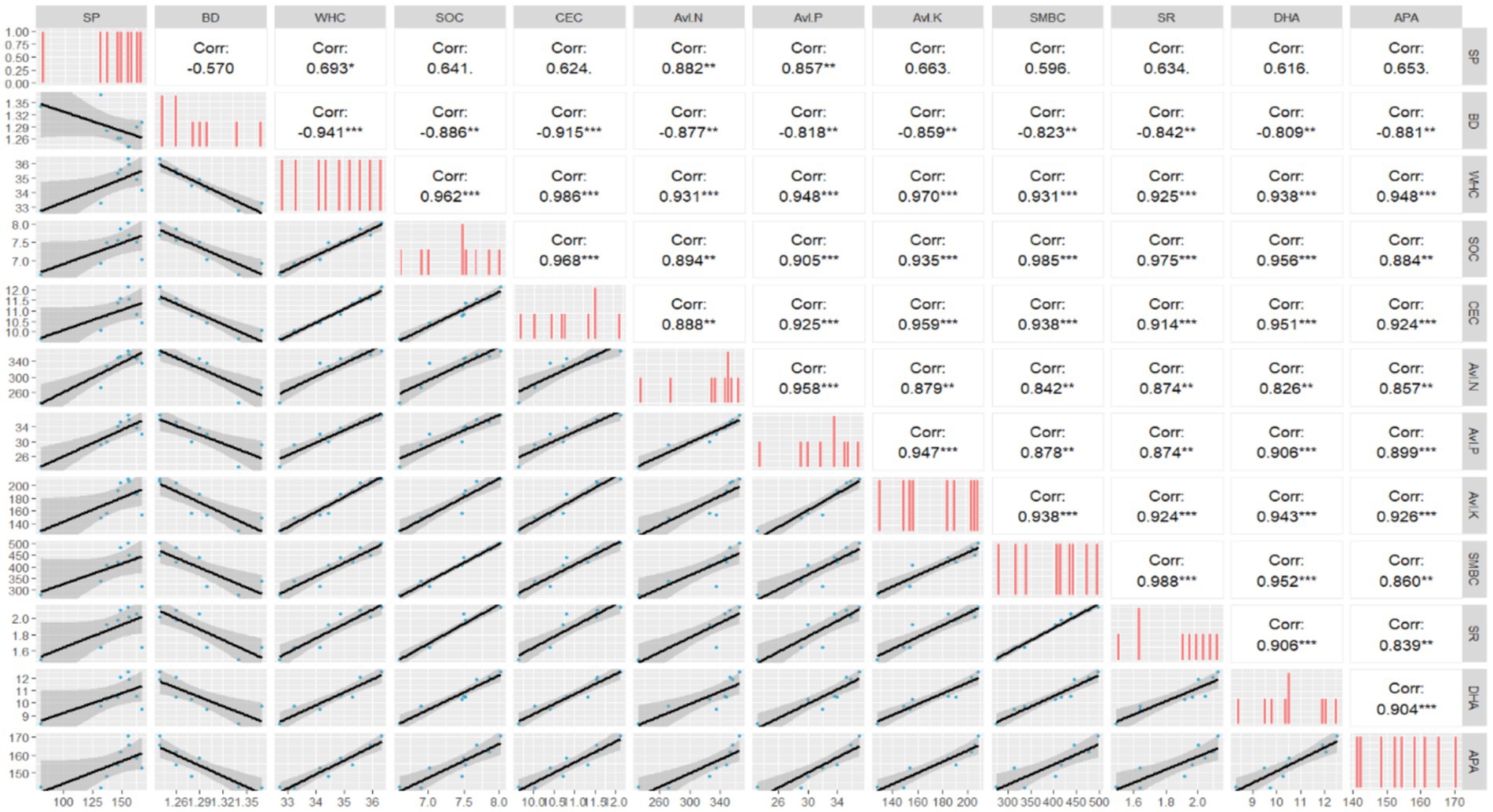
Figure 4. Correlation graph among soil physical, chemical and biological properties with system productivity (mean of 2 years). SP, system productivity; BD, bulk density; WHC, water holding capacity; SOC, soil organic carbon; CEC, cation exchange capacity; Avl-N, soil available N; Avl-P, soil available P; Avl-K, soil available K; SMBC, soil microbial biomass carbon; SR, soil respiration; DHA, dehydrogenase activity; APA, alkaline phosphatase activity. *Significant at the 0.05 level; **Significant at the 0.01 level; ***Significant at the 0.001 level.
5 Conclusion
The study demonstrated that soil physical, biological, and enzymatic properties, as well as system productivity, were significantly influenced by the integration of conservation tillage and organic weed management strategies. Adoption of PBDSR+R fb PBDSM+R, in combination with P-enriched vermicompost mulch, consistently improved BD, water holding capacity, SOC, nutrient availability, SMBC, DHA, APA, and REY, thereby enhancing overall system productivity. Conversely, conventional tillage (CTR fb CTM) had adverse effects on most soil health indicators and system yield. These findings underscore the potential of CA practices, particularly residue retention and nutrient-enriched organic mulches, in improving soil quality and sustaining productivity in RMCS. Thus, based on 2 years of experimentation, the combined adoption of PBDSR+R fb PBDSM+R with P-enriched vermicompost mulch is strongly recommended for improving soil health, optimizing nutrient dynamics, and maximizing system productivity under RMCS in subtropical agro-ecosystems.
Our study was confined to a single location in the eastern Indo-Gangetic Plains, which may limit the broader applicability of the results across different agro-climatic regions. Future research should prioritize multi-location validation studies across diverse agro-climatic zones of the Indo-Gangetic Plains to establish regional adaptation protocols for P-enriched vermicompost mulch application rates and timing. Long-term assessment (≥10 years) of soil carbon sequestration potential and greenhouse gas emissions under PBDSR+R fb PBDSM+R systems is essential to quantify climate mitigation benefits and establish comprehensive carbon footprint assessments. Additionally, optimization of organic mulch composition through investigation of different nutrient-enriched organic amendments (N-enriched, K-enriched, micronutrient-fortified) could address specific soil fertility constraints prevalent in the region. Integration with precision agriculture technologies to develop site-specific application protocols for organic mulches based on soil testing and crop nutrient requirements represents a promising avenue for enhancing resource use efficiency. Finally, participatory research with farmers to evaluate adoption barriers, develop locally appropriate organic mulch production systems, and assess socio-economic impacts on rural livelihoods in the eastern Indo-Gangetic Plains would facilitate successful technology transfer and sustainable implementation of conservation agriculture practices.
Data availability statement
The datasets presented in this study can be found in online repositories. The names of the repository/repositories and accession number(s) can be found at: https://krishikosh.egranth.ac.in/assets/pdfjs/web/viewer.html?file=https%3A%2F%2Fkrishikosh.egranth.ac.in%2Fserver%2Fapi%2Fcore%2Fbitstreams%2F61729f92-2364-4b76-868e-c1b20e9e6897%2Fcontent.
Ethics statement
Ethical review and approval was not required for the study on human participants in accordance with the local legislation and institutional requirements. Written informed consent from the (patients/participants or patients/participants legal guardian/next of kin) was not required to participate in this study in accordance with the national legislation and the institutional requirements.
Author contributions
SubS: Visualization, Formal analysis, Resources, Data curation, Validation, Methodology, Supervision, Conceptualization, Writing – original draft. DR: Investigation, Conceptualization, Resources, Writing – review & editing, Validation, Data curation, Visualization, Methodology, Formal analysis. SR: Formal analysis, Writing – original draft, Data curation, Methodology, Validation, Writing – review & editing, Software. SoS: Validation, Data curation, Methodology, Writing – review & editing, Software, Resources. SumS: Methodology, Data curation, Validation, Writing – original draft, Writing – review & editing, Formal analysis, Software. DN: Data curation, Formal analysis, Software, Resources, Writing – review & editing. MA: Validation, Writing – review & editing, Software, Resources. NA: Software, Resources, Validation, Data curation, Writing – review & editing. MS: Software, Writing – review & editing, Data curation, Resources, Formal analysis.
Funding
The author(s) declare that financial support was received for the research and/or publication of this article. The authors would like to thank Dr. Rajendra Prasad Central Agricultural University, Pusa, Bihar, India. Authors sincerely acknowledge Ongoing Research Funding Program, (ORF-2025-751), King Saud University, Riyadh, Saudi Arabia for supporting current study.
Acknowledgments
Authors thankfully acknowledge the research facilities provided by Dr. Rajendra Prasad Central Agricultural University, Pusa, Bihar, India. They extend the support through Ongoing Research Funding Program, (ORF-2025-751), King Saud University, Riyadh, Saudi Arabia.
Conflict of interest
The authors declare that the research was conducted in the absence of any commercial or financial relationships that could be construed as a potential conflict of interest.
Generative AI statement
The authors declare that no Gen AI was used in the creation of this manuscript.
Publisher’s note
All claims expressed in this article are solely those of the authors and do not necessarily represent those of their affiliated organizations, or those of the publisher, the editors and the reviewers. Any product that may be evaluated in this article, or claim that may be made by its manufacturer, is not guaranteed or endorsed by the publisher.
References
Abdallah, A. M., Jat, H. S., Choudhary, M., Abdelaty, E. F., Sharma, P. C., and Jat, M. L. (2021). Conservation agriculture effects on soil water holding capacity and water-saving varied with management practices and agroecological conditions: a review. Agronomy 11:1681. doi: 10.3390/agronomy11091681
Ahmad, N., Virk, A. L., Hafeez, M. B., Ercisli, S., Golokhvast, K. S., Qi, Y., et al. (2024). Effects of different tillage and residue management systems on soil organic carbon stock and grain yield of rice–wheat double cropping system. Ecol. Indic. 158:111452. doi: 10.1016/j.ecolind.2023.111452
Aksakal, E. L., Sari, S., and Angin, I. (2016). Effects of vermicompost application on soil aggregation and certain physical properties. Land Degrad. Dev. 27, 983–995. doi: 10.1002/ldr.2350
Alef, K., Nannipieri, P., and Trasar-Cepeda, C. (1995). “Phosphatase activity” in Methods in applied soil microbiology and biochemistry. eds. K. Alef and P. Nannipieri (London: Academic Press), 335–336.
Anderson, T. H., and Domsch, K. H. (2010). Soil microbial biomass: the eco-physiological approach. Soil Biol. Biochem. 42, 2039–2043. doi: 10.1016/j.soilbio.2010.06.026
Awgchew, H., Beyene, S., and Kifilu, A. (2024). Potassium adsorption capacity and desorption kinetics in soils of Qenberenaweti sub-watershed, central highlands of Ethiopia. Heliyon 10:e31336. doi: 10.1016/j.heliyon.2024.e31336
Balík, J., Suran, P., Černý, J., Sedlář, O., Kulhánek, M., and Procházková, S. (2025). Changes in soil organic matter content and quality after application of different organic and mineral fertilisers in 27 years long-term field experiments on Luvisol. Front. Soil Sci. 5:1540137. doi: 10.3389/fsoil.2025.1540137
Bekele, A., Kibret, K., Bedadi, B., Balemi, T., and Yli-Halla, M. (2018). Effects of lime, vermicompost and chemical P fertilizer on yield of maize in Ebantu District, western highlands of Ethiopia. Afr. J. Agric. Res. 13, 477–489. doi: 10.5897/AJAR2017.12949
Belda, R. M., Mendoza-Hernández, D., and Fornes, F. (2013). Nutrient-rich compost versus nutrient-poor vermicompost as growth media for ornamental-plant production. J. Plant Nutr. Soil Sci. 176, 827–835. doi: 10.1002/jpln.201200325
Bian, H., Li, C., Zhu, J., Xu, L., Li, M., Zheng, S., et al. (2022). Soil moisture affects the rapid response of microbes to labile organic C addition. Front. Ecol. Evol. 10:857185. doi: 10.3389/fevo.2022.857185
Blake, G. R., and Hartge, K. H. (1986). “Bulk density” in Methods of soil analysis: Part 1—Physical and mineralogical methods. ed. A. Klute (Madison, WI: ASA and SSSA), 363–375.
Blouin, M., Barrere, J., Meyer, N., Lartigue, S., Barot, S., and Mathieu, J. (2019). Vermicompost significantly affects plant growth. A meta-analysis. Agron. Sustain. Dev. 39:34. doi: 10.1007/s13593-019-0579-x
Casida, L. E. Jr., Klein, D. A., and Santoro, T. (1964). Soil dehydrogenase activity. Soil Sci. 98, 371–376. doi: 10.1097/00010694-196412000-00004
Chakraborty, R., Sharma, V. K., Das, D., Biswas, D. R., Mahapatra, P., Shahi, D. K., et al. (2024). Change in phosphorus availability, fractions, and adsorption-desorption by 46-years of long-term nutrient management in an Alfisol of eastern India. Soil and Tillage Research 236, 105940. doi: 10.1016/j.still.2023.105940
Cordeau, S. (2022). Conservation agriculture and agroecological weed management. Agronomy 12:867. doi: 10.3390/agronomy12040867
Das, A., Babu, S., Singh, R., Kumar, S., Rathore, S. S., Singh, V. K., et al. (2022). Impact of live mulch-based conservation tillage on soil properties and productivity of summer maize in Indian Himalayas. Sustainability 14:12078. doi: 10.3390/su141912078
Ding, Y., Gao, X., Shu, D., Siddique, K. H. M., Song, X., Wu, P., et al. (2024). Enhancing soil health and nutrient cycling through soil amendments: improving the synergy of bacteria and fungi. Sci. Total Environ. 923:171332. doi: 10.1016/j.scitotenv.2024.171332
Dutta, A., Patra, A., Hazra, K. K., Nath, C. P., Kumar, N., and Rakshit, A. (2022). A state of the art review in crop residue burning in India: previous knowledge, present circumstances and future strategies. Environ. Challenges 8:100581. doi: 10.1016/j.envc.2022.100581
El Mekkaoui, A., Moussadek, R., Mrabet, R., Douaik, A., El Haddadi, R., Bouhlal, O., et al. (2023). Effects of tillage systems on the physical properties of soils in a semi-arid region of Morocco. Agriculture 13:683. doi: 10.3390/agriculture13030683
Fu, B., Chen, L., Huang, H., Qu, P., and Wei, Z. (2021). Impacts of crop residues on soil health: a review. Environ. Pollut. Bioavailability 33, 164–173. doi: 10.1080/26395940.2021.1948354
Ghimire, R., Lamichhane, S., Acharya, B. S., Bista, P., and Sainju, U. M. (2017). Tillage, crop residue, and nutrient management effects on soil organic carbon in rice-based cropping systems: a review. J. Integr. Agric. 16, 1–15. doi: 10.1016/S2095-3119(16)61337-0
Gomez, K. A., and Gomez, A. A. (1984). “Statistical procedures for agricultural research” in An international Rice research institute book. 2nd ed (New York, NY: John Wiley and Sons), 108–109.
Hailu, L., and Teka, W. (2024). Potential of conservation agriculture practice in climate change adaptation and mitigation in Ethiopia: a review. Front. Clim. 6:1478923. doi: 10.3389/fclim.2024.1478923
Hao, J., Xu, W., Song, J., Gao, G., Bai, J., Yu, Q., et al. (2023). Adaptability of agricultural soil microbial nutrient utilization regulates community assembly under mulching measures on the loess plateau. Agric. Ecosyst. Environ. 357:108702. doi: 10.1016/j.agee.2023.108702
Honda, S., Ohkubo, S., San, N. S., Nakkasame, A., Tomisawa, K., Katsura, K., et al. (2021). Maintaining higher leaf photosynthesis after heading stage could promote biomass accumulation in rice. Sci. Rep. 11:7579. doi: 10.1038/s41598-021-86983-9
ICAR-NRRI. (2019). Rice research for enhancing productivity, profitability and climate resilience. Cuttack: ICAR-National Rice Research Institute. 150.
Jackson, M. L. (1973). Soil chemical analysis. New Delhi: Prentice Hall of India Pvt. Ltd., 183–408.
Jat, M. L., Chakraborty, D., Ladha, J. K., Parihar, C. M., Datta, A., Mandal, B., et al. (2022). Carbon sequestration potential, challenges, and strategies towards climate action in smallholder agricultural systems of South Asia. Crop Environ. 1, 86–101. doi: 10.1016/j.crope.2022.03.005
Jat, R., Singh, R. G., Kumar, M., Jat, M., Parihar, C., Bijarniya, D., et al. (2019). Ten years of conservation agriculture in a rice–maize rotation of eastern Gangetic Plains of India: yield trends, water productivity and economic profitability. Field Crop Res. 232, 1–10. doi: 10.1016/j.fcr.2018.12.004
Katiyar, R. B., Sundaramurthy, S., Sharma, A. K., Arisutha, S., Khan, M. A., and Sillanpää, M. (2023). Optimization of engineering and process parameters for vermicomposting. Sustainability 15:8090. doi: 10.3390/su15108090
Kumar, N., Sow, S., Rana, L., Ranjan, S., and Singh, A. K. (2024). Trash amended with Trichoderma effects on cane yield, soil carbon dynamics, and enzymatic activities under plant–ratoon system of sugarcane in calcareous soil. Sugar Tech 27, 134–147. doi: 10.1007/s12355-024-01467-0
Lei, X., Shen, Y., Zhao, J., Huang, J., Wang, H., Yu, Y., et al. (2023). Root exudates mediate the processes of soil organic carbon input and efflux. Plants 12:630. doi: 10.3390/plants12030630
Li, J., Hoang, K. T. K., Hassan, N., and Marschner, P. (2019). Vermicompost influences soil P pools and available N—effect of placement and combination with inorganic fertiliser. J. Soil Sci. Plant Nutr. 19, 900–905. doi: 10.1007/s42729-019-00088-x
Liu, W., Yang, Z., Ye, Q., Peng, Z., Zhu, S., Chen, H., et al. (2023). Positive effects of organic amendments on soil microbes and their functionality in agro-ecosystems. Plants 12:3790. doi: 10.3390/plants12223790
Malobane, M. E., Nciizah, A. D., Nyambo, P., Mudau, F. N., and Wakindiki, I. I. C. (2020). Microbial biomass carbon and enzyme activities as influenced by tillage, crop rotation and residue management in a sweet sorghum cropping system in marginal soils of South Africa. Heliyon 6:e05513. doi: 10.1016/j.heliyon.2020.e05513
Mishra, A. K., Shinjo, H., Jat, H. S., Jat, M. L., Kumar Jat, R., and Funakawa, S. (2024). Conservation agriculture enhances crop productivity and soil carbon fractions in indo-Gangetic Plains of India. Front. Sustain. Food Syst. 8:1476292. doi: 10.3389/fsufs.2024.1476292
Mondal, S., Chakraborty, D., Das, T. K., Shrivastava, M., Mishra, A. K., Bandyopadhyay, K. K., et al. (2019). Conservation agriculture had a strong impact on the sub-surface soil strength and root growth in wheat after a 7-year transition period. Soil Tillage Res. 195:104385. doi: 10.1016/j.still.2019.104385
Olsen, S. R., Cole, C. V., Watanabe, F. S., and Dean, L. A. (1954). Estimation of available phosphorus in soils by extraction with sodium bicarbonate. Washington, DC: United States Department of Agriculture.
Ondrasek, G., Rengel, Z., Petosic, D., and Filipovic, V. (2014). Land and water management strategies for the improvement of crop production. Emerging Technol. Manage. Crop Stress Tolerance 2, 291–313. doi: 10.1016/B978-0-12-800875-1.00013-2
Orzech, K., Wanic, M., and Załuski, D. (2021). The effects of soil compaction and different tillage systems on the bulk density and moisture content of soil and the yields of winter oilseed rape and cereals. Agriculture 11:666. doi: 10.3390/agriculture11070666
Oyege, I., and Balaji Bhaskar, M. S. (2023). Effects of vermicompost on soil and plant health and promoting sustainable agriculture. Soil Systems 7:101. doi: 10.3390/soilsystems7040101
Page, A. L., Miller, R. H., and Keeney, D. R.. (1982). Methods of Soil Analysis. Part 2. Chemical and Microbiological Properties. American Society of Agronomy. Soil Sci. Soc. Am. 1159.
Pan, C. C., and Huang, C. H. (2024). Cow dung compost and vermicompost amendments promote soil carbon stock by enhancing labile organic carbon and residual oxidizable carbon fractions in maize field soil. Soil Use Manag. 40:e13122. doi: 10.1111/sum.13122
Parastesh, F., Alikhani, H. A., and Etesami, H. (2019). Vermicompost enriched with phosphate–solubilizing bacteria provides plant with enough phosphorus in a sequential cropping under calcareous soil conditions. J. Clean. Prod. 221, 27–37. doi: 10.1016/j.jclepro.2019.02.234
Parihar, C. M., Singh, A. K., Jat, S. L., Dey, A., Nayak, H. S., Mandal, B. N., et al. (2020). Soil quality and carbon sequestration under conservation agriculture with balanced nutrition in intensive cereal-based system. Soil Tillage Res. 202:104653. doi: 10.1016/j.still.2020.104653
Pathak, H., Samal, P., and Shahid, M. (2018). “Revitalizing rice-systems for enhancing productivity, profitability and climate resilience” in Rice research for enhancing productivity, profitability and climate resilience. ed. H. Pathak (Cuttack: ICAR-National Rice Research Institute), 1–17.
Pradhan, P. R., Pandey, R. N., Behera, U. K., Swarup, A., Datta, S. C., and Dwivedi, B. S. (2011). Tillage and crop residue management practices on crop productivity, phosphorus uptake and forms in wheat (Triticum aestivum)-based cropping systems. Indian J. Agric. Sci. 81:1168.
Pramanick, B., Kumar, M., Naik, B. M., Singh, S. K., Kumar, M., and Singh, S. V. (2024). Soil carbon-nutrient cycling, energetics, and carbon footprint in calcareous soils with adoption of long-term conservation tillage practices and cropping systems diversification. Sci. Total Environ. 912:169421. doi: 10.1016/j.scitotenv.2023.169421
Romaniuk, R., Giuffré, L., and Romero, R. (2011). A soil quality index to evaluate the vermicompost amendments effects on soil properties. J. Environ. Prot. 2, 502–510. doi: 10.4236/jep.2011.25058
Roper, M., Kerr, R., Ward, P., Micin, S., and Krishnamurthy, P. (2021). Changes in soil properties and crop performance on stubble-burned and cultivated water-repellent soils can take many years following reversion to no-till and stubble retention. Geoderma 402:115361. doi: 10.1016/j.geoderma.2021.115361
Sande, T. J., Tindwa, H. J., Alovisi, A. M. T., Shitindi, M. J., and Semoka, J. M. (2024). Enhancing sustainable crop production through integrated nutrient management: a focus on vermicompost, bio-enriched rock phosphate, and inorganic fertilisers–a systematic review. Front. Agron. 6:1422876. doi: 10.3389/fagro.2024.1422876
Saurabh, K., Rao, K. K., Mishra, J. S., Kumar, R., Poonia, S. P., Samal, S. K., et al. (2021). Influence of tillage-based crop establishment and residue management practices on soil quality indices and yield sustainability in rice-wheat cropping system of eastern indo-Gangetic Plains. Soil Tillage Res. 206:104841. doi: 10.1016/j.still.2020.104841
Sepat, S., Thierfelder, C., Sharma, A. R., Pavuluri, K., Kumar, D., Iquebal, M. A., et al. (2017). Effects of weed control strategy on weed dynamics, soybean productivity and profitability under conservation agriculture in India. Field Crop Res. 210, 61–70. doi: 10.1016/j.fcr.2017.05.017
Shah, S. S., van Dam, J., Singh, A., Kumar, S., Kumar, S., Bundela, D. S., et al. (2025). Impact of irrigation, fertilizer, and pesticide management practices on groundwater and soil health in the rice–wheat cropping system—a comparison of conventional, resource conservation technologies and conservation agriculture. Environ. Sci. Pollut. Res. 32, 533–558. doi: 10.1007/s11356-024-35661-0
Shankar, T., Malik, G. C., Banerjee, M., Dutta, S. K., Maitra, S., Praharaj, S., et al. (2021). Productivity and nutrient balance of an intensive rice–rice cropping system are influenced by different nutrient management in the red and lateritic belt of West Bengal, India. Plants 10:1622. doi: 10.3390/plants10081622
Sharma, S., Singh, P., Ali, H. M., Siddiqui, M. H., and Iqbal, J. (2023). Tillage, green manuring and crop residue management impacts on crop productivity, potassium use efficiency and potassium fractions under rice-wheat system. Heliyon 9:e17828. doi: 10.1016/j.heliyon.2023.e17828
Sharma, S., Singh, P., and Kumar, S. (2020). Responses of soil carbon pools, enzymatic activity, and crop yields to nitrogen and straw incorporation in a rice-wheat cropping system in North-Western India. Front. Sustain. Food Syst. 4:532704. doi: 10.3389/fsufs.2020.532704
Shaukat, M., Ahmad, A., Khaliq, T., Hoshide, A. K., and de Abreu, D. C. (2023). Organic amendments and reduced tillage accelerate harvestable C biomass and soil C sequestration in rice–wheat rotation in a semi-arid environment. Sustainability 15:6415. doi: 10.3390/su15086415
Shyam, A., Sharma, D. P., Dogra, R. K., and Kaushal, R. (2023). Improved soil physico-chemical characteristics, soil moisture and plant growth properties through vertical mulching in a plum orchard. Biol. Agric. Hortic. 39, 283–304. doi: 10.1080/01448765.2023.2217526
Siedt, M., Schäffer, A., Smith, K. E., Nabel, M., Roß-Nickoll, M., and Van Dongen, J. T. (2021). Comparing straw, compost, and biochar regarding their suitability as agricultural soil amendments to affect soil structure, nutrient leaching, microbial communities, and the fate of pesticides. Sci. Total Environ. 751:141607. doi: 10.1016/j.scitotenv.2020.141607
Sow, S., Kumar, N., Rana, L., Singh, A. K., Kumar, V., Singh, H., et al. (2025). Suitable planting material with integrated nutrient management can enhance productivity, nutrient use efficiency and profitability of sugarcane. J. Soil Sci. Plant Nutr. 25, 3652–3675. doi: 10.1007/s42729-025-02358-3
Subbiah, B. V., and Asija, G. L. (1956). A rapid procedure for the estimation of available nitrogen in soils. Curr. Sci. 25, 259–260.
Tabatabai, M. A., and Bremner, J. A. (1969). Use of p-nitrophenyl phosphate for assay of soil phosphatase activity. Soil Biol. Biochem. 1, 301–307. doi: 10.1016/0038-0717(69)90012-1
Tripathi, S. C., Kumar, N., Venkatesh, K., and Meena, R. P. (2025). Enhancing energetics, system productivity, profitability and soil fertility in maize based cropping system by conservation Vis a Vis conventional agriculture in north-West India. Int. J. Plant Prod. 19, 117–130. doi: 10.1007/s42106-024-00323-1
Tuti, M. D., Rapolu, M. K., Sreedevi, B., Bandumula, N., Kuchi, S., Bandeppa, S., et al. (2022). Sustainable intensification of a rice–maize system through conservation agriculture to enhance system productivity in southern India. Plants 11:1229. doi: 10.3390/plants11091229
Vance, E. D., Brookes, P. C., and Jenkinson, D. S. (1987). An extraction method for measuring soil microbial biomass C. Soil Biol. Biochem. 19, 703–707. doi: 10.1016/0038-0717(87)90052-6
Walkley, A., and Black, I. A. (1934). An examination of the Degtjareff method for determining soil organic matter, and a proposed modification of the chromic acid titration method. Soil Sci. 37, 29–38. doi: 10.1097/00010694-193401000-00003
Wang, F., Wang, X., and Song, N. (2021). Biochar and vermicompost improve the soil properties and the yield and quality of cucumber (Cucumis sativus L.) grown in plastic shed soil continuously cropped for different years. Agric. Ecosyst. Environ. 315:107425. doi: 10.1016/j.agee.2021.107425
Wu, Q., Zhang, J., Liu, X., Chang, T., Wang, Q., Shaghaleh, H., et al. (2023). Effects of biochar and vermicompost on microorganisms and enzymatic activities in greenhouse soil. Front. Environ. Sci. 10:1060277. doi: 10.3389/fenvs.2022.1060277
Yadav, G. S., Babu, S., Das, A., Datta, M., Mohapatra, K. P., Singh, R., et al. (2021). Productivity, soil health, and carbon management index of Indian Himalayan intensified maize-based cropping systems under live mulch based conservation tillage practices. Field Crop Res. 264:108080. doi: 10.1016/j.fcr.2021.108080
Yao, B., Wang, X., Li, Y., Lian, J., Li, Y., Luo, Y., et al. (2023). Soil extracellular enzyme activity reflects the change of nitrogen to phosphorus limitation of microorganisms during vegetation restoration in semi-arid sandy land of northern China. Front. Environ. Sci. 11:1298027. doi: 10.3389/fenvs.2023.1298027
Keywords: permanent bed, rice-maize, SMBC, SOC, soil respiration, system productivity, vermicompost mulch, zero tillage
Citation: Sahoo S, Roy DK, Ranjan S, Sadhu S, Sow S, Nath D, Alotaibi M, Ali N and Seleiman MF (2025) Improving soil health and system productivity through conservation agriculture and weed management strategies in rice-maize cropping system. Front. Sustain. Food Syst. 9:1632921. doi: 10.3389/fsufs.2025.1632921
Edited by:
Abhishek Kumar, University of California, Davis, United StatesReviewed by:
Urjashi Bhattacharya, The Neotia University, IndiaArpita Roy, Birla Institute of Technology, Mesra, India
Copyright © 2025 Sahoo, Roy, Ranjan, Sadhu, Sow, Nath, Alotaibi, Ali and Seleiman. This is an open-access article distributed under the terms of the Creative Commons Attribution License (CC BY). The use, distribution or reproduction in other forums is permitted, provided the original author(s) and the copyright owner(s) are credited and that the original publication in this journal is cited, in accordance with accepted academic practice. No use, distribution or reproduction is permitted which does not comply with these terms.
*Correspondence: Dhirendra Kumar Roy, ZGtyb3l3Y0BnbWFpbC5jb20=; Shivani Ranjan, cmFuamFuc2hpdmFuaTU0QGdtYWlsLmNvbQ==; Sumit Sow, c3VtaXRzb3cxOUBnbWFpbC5jb20=
†These authors share first authorship
‡ORCID: Shivani Ranjan, https://orcid.org/0000-0002-3336-448X
Sumit Sow, https://orcid.org/0000-0003-3074-9699
 Subhra Sahoo
Subhra Sahoo Dhirendra Kumar Roy1*†
Dhirendra Kumar Roy1*† Shivani Ranjan
Shivani Ranjan Souvik Sadhu
Souvik Sadhu Sumit Sow
Sumit Sow Dibyajyoti Nath
Dibyajyoti Nath Majed Alotaibi
Majed Alotaibi Nawab Ali
Nawab Ali Mahmoud F. Seleiman
Mahmoud F. Seleiman